#the ideal of the nuclear!! which the finale does include. hope this helps :)
Explore tagged Tumblr posts
Text
just remembered someone saying they disliked the finale cause sam should've become a reclusive professor or something adjacent... like yeah the same sam who has definitelyyyy expressed any interest in becoming an educator or having that role or any role(s) adjacent... the same sam who has definitelyyyy had explored arcs relating to that idea... on the show that definitelyyyyy themes or allegories relating to the idea of education/teacher/roles relating... sure...
#don't piss me off#you know what sam has several arcs relating to + is a fundamental theme of supernatural?#the ideal of the nuclear!! which the finale does include. hope this helps :)#jared 'i'll tutor you in college algebra!' / 'i'd love to be an english teacher' padalecki is more likely to become a prof than sam ever was#. sorry#same people who turn around and br posts about how supernatural doesn't explore it's own themes i can't fucking dealllllll#ludere
21 notes
·
View notes
Text
Iron Man's Morality
by Damien F
Friday, 09 May 2008Damien F trys to figure out Iron Man's sense of right and wrong.~
This month saw the synthesised superhero Iron Man join the ever-increasing canon of Marvel characters adapted for the screen. Played Robert Downey Jr, and directed by Jon Favreau (who appears onscreen as some sort of unacknowledged personal assistant),
Iron Man refreshes Marvel's old metal-clad, commie-bashing trailblazer, who unknown but to a select few (which includes almost everyone. Iron Man has to be the least secret secret identity in the history of comic-books) is billionaire industrialist and genius arms manufacturer Tony Stark.
The best that can be said about this film is that it's not awful, raising it above the likes of Daredevil,The Fantastic Four and The Punisher, among others. It's a largely competent, if silly, two hours of Hollywood entertainment, and as the first blockbuster event-movie of the summer, it inspires hope that this season's offerings will be a significant improvement over last year's dreadful showing.
However, just as it avoids sinking to the lowest levels for this kind of film, it fails to hit the heights it aspires to. It lacks the intelligence and social consciousness that marked Batman Beyond and the X-Men series, as well as the sense of humanity that made the Spider-Man films essential for fans and newcomers alike.
Seemingly aware of this, Favreau has tried to inject Iron Man with another attribute: morality. The story, admirably faithful to the comic's origins, tells us of the playboy Stark who fails to recognise the consequences of his actions. Be they the friends left stranded at an award ceremony held in his honour while he parties with floozies at a Las Vegas casino, or the innocents killed by the weapons he produces. As he explains to a hostile reporter (shortly before bedding her), his products are essential in maintaining a global balance of power, which ultimately serves to save lives. He has a change of heart, however, when he is captured by terrorists in Afghanistan while displaying the latest Stark Industries weapon the "Jericho" to military officials. Here he sees the true effect his weapons are having on the world, as the terrorists are armed with his company's products. They demand he builds for them their own Jericho. Instead Tony builds an electric-powered suit of armour for himself under their noses and makes good his escape. Afterwards, vowing to protect the people put in harms way by his weaponry, he fashions a more sophisticated, stylish version of the suit and becomes Iron Man, flying around the world at super-sonic speed destroying the militias armed with Stark Industry weapons.
Unfortunately, his morality becomes the film's most critical malfunction. The Iron Man suit is armed with all manner of guns to rocket launchers, and Tony expresses no qualms about killing those who apparently deserve being killed. Effectively, it's a weapon itself, and we're expected to accept that its presence makes the world safer when the sale of Jericho missiles represents such a threat? Perhaps the answer to this lies in who controls the weapons. Where as Stark missiles were sold on a free market, the Iron Man suit is owed and operated by nobody but Tony. However, just as he was naive to believe his weapons would only be used by forces interested in stabilising world peace, it transpires that Tony can't protect the technology for the suit falling into the wrong hands. The issue of a central a source of control of power is also belied by a scene where Iron Man confronts a group attacking an unidentified Middle-Eastern village. After killing the foot-soldiers, he delivers their leader to the villagers and invites them to do what they like with him before flying away and leaving them at it. We jump from highly central military control to mob justice in a single breath.
The confused nature of the films morality is not helped by its generic look at international conflicts. We are told that Tony is kidnapped in Afghanistan, but the true aims of his kidnappers are never fully explained. We can't write them off as the Taliban, as they seem to be a loose alliance of terrorists from all over the world. Following this the film alludes to ethnic-cleansing of regions by the same group, but we are never told why. The Marvel comics have rarely strayed from addressing real-life events such as Northern Ireland or 9/11 (the Marvel superheroes are currently being drafted to the image of the UN). These are usually discussed in a highly superficial way, but it's admirable that they have the nerve to discuss them at all. For a film that seeks to address the affects of Western military involvement in the developing world, it would have been refreshing if they referred directly to the arming of real-life militias, such as the Taliban by Western governments rather than just gutlessly allude to it.
It should be said, however, that one real-life conflict does get a look in. We are given numerous references to World War Two, as we are repeatedly told how Tony's father worked on the Manhattan Project. Presumably the building of the atomic bomb is meant to serve as a metaphor for the construction of a hyper-powered suit of armour. Prior to his kidnapping, Tony tells us that the ideal weapon is not one you never have to use but one you only have to use once. The allusion to the atomic bomb is clear. The trouble with this is that Tony is never asked to consider if the bomb was a mistake. For all the people who mention his father's role in the project, nobody asks if he regretted this or stood by the project. An internal debate over the true nature of nuclear weapons, be they war at its most corrupt and evil or the single stabilising factor in conflicts between super-states, might have serve to address the flaws in the films muddied morality. As it stands, this is just a wasted opportunity.
For those interested in seeing this film, these flaws should not dissuade you. Fans of the comics can rejoice the film's faithfulness to its source material. They even manage to fit in Iron Man's original clunky, aesthetically displeasing armour. Praise can also be bestowed on Downey's performance as Tony Stark. A few eyebrows were raised when the decision to give him the role was announced, as it was doubted the former wild-boy could handle a leading role on such a major production, and his physic could hardly be described as super-powered. However, I suspect fans were delighted with the casting, as his hell-raising antics were suitably in tune with the charismatic Stark. On screen, the choice seems inspired. Jeff Bridges also has a ball as the villain Ironmonger. However, Gwyneth Paltrow is simply annoying as the love interest Pepper Potts. And then there's that bloody reporter, who keeps turning up like a crazed stalker ex-girlfriend.
The special effects for the suit are a joy to watch, but the action sequences lack a required energy. Watching metallic men fight serves only to remind us how much more fun last year's Transformers was. Overall, Iron Man is far from essential, but enjoyable enough if you do give it a chance. I just wish they figured out the sermon before taking to the alter.
Themes:
TV & Movies
~
bookmark this with - facebook - delicious - digg - stumbleupon - reddit
~Comments (
go to latest
)
Arthur B
at 13:15 on 2008-05-09The thing is, Tony Stark is basically a neo-con (witness his role in the recent
Civil War
storyline, which I have been glancing at from afar and tutting at), or rather a comic book writer's vision of a neo-con, so it's probably no surprise that his moral agenda is actually kind of silly and incoherent. From what you say, the film seems to bear this out. Before he's kidnapped he's a pre-9/11 neo-con, selling weapons to the world in the name of an American-dominated balance of terror. Then he has his own personal 9/11 experience, and realises that he can't let proxies do all the work, but has to go out into the world and kick ass all by himself, like George Bush rustlin' up a posse and ridin' out into Afghanistan (briefly) before tackling Iraq. The incoherent presentation of the enemy only matches the incoherent presentation of Terrorism by the Bush administration: are terrorists weak lunatics living in caves, or are they a vast international conspiracy devoted to taking over the world and imposing a global Caliphate? Are we in Iraq to fight terrorists or are we there to allow the Iraqis to choose the government they actually want (which might perhaps include a few terrorists)?
permalink
-
go to top
Jamie Johnston
at 22:34 on 2008-05-21I read this with interest, having a couple of days ago been coaxed into going to see the film with a friend. I agree that it's not a terribly morally sophisticated film, and one might have wished for a bit more exploration of interesting problems. But I think there are a few things to say in its defence.
First, there's a bit of a suggestion here that the film is internally contradictory in that both Iron Man and the film itself appear to espouse a certain moral outlook but Iron Man then behaves in a way inconsistent with this outlook and the film appears to endorse this behaviour. There is an element of this, but not a great deal, I'd suggest.
For example, Damien says that "[t]he Iron Man suit is armed with all manner of guns to rocket launchers, and Tony expresses no qualms about killing those who apparently deserve being killed." We need to distinguish between the two suits. The first one is certainly pretty heavily armed, and he does indeed use it to injure and kill people; but I'd say that's reasonably consistent and plausible in the context of the film as a whole, for several reasons. First, the materials from which he constructs this first suit are themselves armaments of various kinds, and the nature of the materials in such cases may tend to dictate the nature of the final product. Secondly, his main objective at this point is to escape from heavily armed captors who he reasonably believes intend to kill him, and even if we objectively don't accept that the life of one American millionaire is worth more than the lives of several dozen Afghan terrorists we can be reasonably forgiving if he takes the attitude that it's them or him and he knows which option he prefers. Thirdly, he hasn't at this stage had his full-blown epiphany, which seems only to occur with the death of the chap who helped him build the suit. So even if his behaviour at this point isn't especially moral it's at least not altogether hypocritical.
When it comes to the second suit, the criticism is much more deserved, but I would point out that the film makes some sort of attempt to deal with the problem. It's made clear that the initial idea is to make a suit that enables the wearer to fly, and that's it. What later turns out to be the main weapon is originally meant to be a flight-stabilizer, as we're told quite explicitly. He only conceives of using them destructively when, already in a state of considerable frustration, he discovers that his company is still deliberately selling weapons to terrorists. At this point he sets off to visit a terrorist camp and destroy said weapons. Arriving, he does a pretty reasonable job of destroying the artillery without undue injury to the terrorists themselves. When he finds civilians being held at gun-point he does then start killing off terrorists, but again that comes comfortably within what appear to be the film's moral rules since it's a necessary means of protecting innocent people. Where it really does fall down is the fact that he kills the hostage-takers with little shoulder-mounted rockety things that have no obvious flight-related function and must presumably have been intended as weapons when Stark designed the suit. Although that's still some distance from the suit being "armed with all manner of guns to rocket launchers", it still kind of undermines the 'it's only meant to fly' defence. But I still think it's worth noting that the film-makers have at least bothered to put the 'it's only meant to fly' defence in there in the first place, which shows some awareness of the problem of Stark looking self-contradictory.
There also seem to be an implication that the film is unclear or incoherent about what its moral stance is. Again I'm not sure that this is entirely deserved. It's possible to set out in fairly straightforward terms what the moral rules in the film seem to be:
- the USA is good;
- terrorists are bad;
- killing terrorists is okay, at least when they pose a real and moderately imminent threat to civilians and / or Americans;
- killing civilians is not okay;
- killing Americans is not okay unless they are evil super-villains;
- selling weapons to terrorists is bad;
- selling weapons to the US government is probably okay in principle but only with proper controls and mechanisms of accountability to ensure the weapons are used for 'good' ends (such as killing terrorists) and don't end up in the hands of terrorists.
Those rules probably accord pretty well with what a lot of Americans believe, and Iron Man's behaviour in the film by and large follows those rules. They even accommodate Stark facilitating the probably lynching of the bearded terrorist leader (which of course is a pretty close analogy for letting the Iraqis hang the not-wholly-dissimilar-looking Saddam), who is after all a terrorist. If it looks to us as though Stark's failing to live up to his new-found pacifism, it's because he's actually not a pacifist, and never says he is. We make that assumption because it's the most obvious explanation to an audience of arty young British thinking people for a maker and seller of weapons suddenly stopping making and selling weapons; but his conversion is actually a much more limited one that probably makes a lot more sense to the film's target audience.
Of course that brings us straight to what I think is Damien's main point, which is that it's rather disappointing that the film, having decided to ask questions about the arms-trade, comes up with such mainstream American answers without even exploring any other options with any sort of seriousness. That's absolutely right. But even here I'd raise a very partial defence by saying that we may be asking a bit much of the film given what it is. It doesn't tell us what the terrorists' aims are (well, actually it does tell us what their immediate aims are: they've been hired by Stane to kill Stark but when they find out who Stark is they decide he's worth more than what they've been paid and so they decide to force him to build them a big rocket; but it doesn't tell us about the over-all political cause to which this is, as it were, a side-quest). But if it did, wouldn't it then risk becoming a film about "is it right to sell weapons to these particular people in view of their political agenda?" rather than "is it right to sell weapons to terrorists in general?" And it's true that it doesn't engage very meaningfully with the point about the Manhattan project (though I must point out that Stark himself does at one point say he wishes he'd asked his father how he felt about his work). But then again wouldn't any remotely serious examination of the ethics of the atomic bomb be such a big subject as to entirely hijack a superhero action movie and turn it into something quite different?
Again, I don't want to say that the film isn't rather superficial in its treatment of moral questions and rather banal and unchallenging in its answers to those questions. It is. But at least it does (1) show a very limited awareness that the questions exist, (2) come up with a reasonably coherent (if irritatingly Bush-compatible) moral framework, and (3) make some effort to make sense of the apparent paradox of a chap using weapons-technology to destroy weapons. I'm not really sure it could have done much more while still being a superhero block-buster, just like Juno couldn't really do justice to the question of abortion while still being a cute romantic / tennage-pregnancy comedy. X-Men can do more because it does it by metaphor (mutant = black / gay / foreign) and therefore doesn't have to engage with the complex details of real situations. Spider-Man can do more because it concentrates on character and issues that occur on the ordinary human level rather than the social or political level. I'm not sure that Iron Man, given what it was, could really have done much better than it did.
permalink
-
go to top
Dan H
at 09:34 on 2008-05-23Jamie pretty much sums up everything I was going to say about this (although I've not seen the film, I don't see anything inherently contradictory about "it's okay to sell weapons to some people but not others" - it's the same "contradiction" you get in pretty much all movies, books, or whatever with a strong action element. Good Guys pretty much always kill a whole mess o' folks).
What I actually wanted to say was that this reminds me of something a friend of mine once said about
Batman Begins
- on the one level it's trying to be a serious exploration of the nature of fear, but ultimately it's a movie about a guy who dresses up as a bat and fights crime. I think the simple fact is that superhero movies have to work with the themes which their frequently ludicrous premises allow.
permalink
-
go to top
Wardog
at 16:37 on 2008-05-23Mmmm...I'm almost curious now, thanks to Damien and Jamie, but Iron Man has never really appealed to my imagination. I don't know, although I can get behind a man who wants to dress a bat and fight crime, I can't work up the enthusiasm for a guy who makes himself a robot-suit and blows up terrorists.
(I feel terrible - Jamie and Dan and Arthur have said all these insightful things and I've just made this pointlessly frivolous observation)
permalink
-
go to top
Damien F
at 11:18 on 2008-05-27Jamie, I see where you're coming from. Your points on the first suit are spot on, but to be honest I really wasn't considering the first suit when writing the piece. Also, I suppose it's true it does come up with a Bush-flavoured morality (which is a trend I've noticed running through the comics for many years now). Stark arms terrorists and then takes it upon himself to disarm them. The problem I have with this is that it simply ignores the outcomes of these actions, in a pretty literal scenes. Look at your liking of leaving the beardy terrorist to civilians to the lynch-mob "justice" handed down to Saddam (which is something I admit I didn't spot myself). After this scene, Iron Man simply flies away, refusing accountability for what might happen. This was in my opinion lazy and irresponsible, on both Iron Man's part and the film-makers.
There was also a point I wanted to work into the piece but couldn't figure out how. At one point shortly before the fore-mention scene, Iron Man's computer-Jervis-thing distinguishes the terrorists from civilians and dispatches them accordingly. This is a horribly black-and-white approach to its subject matter.
There are two further points I wish to dispute. First, your argument that a more socially-conscious film would have spoilt its blockbuster fun. It may have been harder to make such a film, but not impossible. Since the Victorian days, good sci-fi has always been allegorical.
Second, the assertion that "we make that assumption because it's the most obvious explanation to an audience of arty young British thinking people". I'm Irish.
permalink
-
go to top
Arthur B
at 11:43 on 2008-05-27
After this scene, Iron Man simply flies away, refusing accountability for what might happen. This was in my opinion lazy and irresponsible, on both Iron Man's part and the film-makers.
Are you sure that the film-makers weren't intending you to come away with the impression that Iron Man is a bit lazy and irresponsible? I've not seen the film, so it's down to those that have to make the call, but when I saw the trailers they seemed to suggest a bit of moral ambiguity on Stark's part (which would make sense given his not-exactly-clean history in the comics).
permalink
-
go to top
Jamie Johnston
at 17:35 on 2008-05-27After this scene, Iron Man simply flies away, refusing accountability for what might happen. This was in my opinion lazy and irresponsible, on both Iron Man's part and the film-makers.
Yes, that was certainly the moment that put the greatest strain on my efforts to regard him as heroic. Arthur may be right to guess that at that point in the film we were supposed to be feeling a bit uneasy about his behaviour, especially since that's followed by what must have been quite a challenging scene for a patriotic American audience, in which a handful of US fighter 'planes try to shoot Iron Man down and he ends up (albeit accidentally) causing one of them to crash. Possibly we were only meant to come fully behind Iron Man when he saves the bailed-out pilot. It's hard to say.
Actually that brings to mind another point I hadn't thought about: the most morally problematic parts of the film are these bits in the middle, where he's engaged in his minimally thought-out anti-terrorist exercise. It gets much simpler when he comes back and gets stuck in to the 'main' plot of (1) stopping the technology falling into the hands of the clear-cut crazy villain and (2) trying not to get killed by the clear-cut crazy villain. Which I guess is one of the main things about super-heroes in general: much of the time, the thing that stops us regarding them as morally questionable is the fact that they're clearly better than whatever implausibly evil villain they're fighting. And that's a point that I suppose supports your argument more than mine, in that the least morally successful bits of the film are, as you've said, the ones where Iron Man is engaging with vaguely real-world issues like terrorism and the international arms trade.
First, your argument that a more socially-conscious film would have spoilt its blockbuster fun. It may have been harder to make such a film, but not impossible. Since the Victorian days, good sci-fi has always been allegorical.
Ah, well, yes, I wouldn't want to say it's impossible, but I think your point about allegory is important, and it links with my rather brief earlier comparison to the 'X-Men' films. The latter are genuinely allegorical, and I'd say that's what makes it easier for them to produce both moderately worthwhile moral / social commentary and super-hero blockbuster fun. What they don't do is what 'Iron Man' does attempt and, as you say, doesn't do very well, which is to have the characters get literally involved in real-world situations. The X-Men don't literally fight against homophobes or xenophobes, and they don't literally get hauled up before the Committee On Un-American Activities. If they did, then I'd say there's a good chance those films would end up just as unsatisfactory in that respect as 'Iron Man', because when you allegorize you can both simplify and dramatize much more easily and effectively.
Second, the assertion that "we make that assumption because it's the most obvious explanation to an audience of arty young British thinking people". I'm Irish.
Ah, my apologies! Actually so am I, at least on paper, thanks to Ireland's wonderfully welcoming rules of citizenship. My new harp-emblazoned passport is in the post at the moment, in fact. But you know what I mean. :)
permalink
-
go to top
Wardog
at 16:46 on 2008-05-28I'm just going to start wildly throwing out opinions here despite not having seen the movie because, well, hey it's never stopped me before. I think the thing about X-Men which is, as you say, genuinely allegorical is that although if you were to Take It Very Seriously you could say it's about social acceptance / xenophobia, what it's most convincingly about is being a teenager, specifically the sort of clever, socially-awkward, comic-reading sort of teeanger that I and, ahem, I suspect several of us here were once upon a time - feeling different to, and excluded from, the rest of the world. And because it's very personal it doesn't strain credibility. Whereas it seems to me (from my position of total ignorance) that using comic book heroes to comment on wider social / political issues only draws attention to how necessarily and inappropriately simplistic such commentary must be.
permalink
-
go to top
Jamie Johnston
at 18:28 on 2008-06-02Mmm, yes, I hadn't thought of that but you're quite right. I guess that comes out better in the films than in the comics, in some ways, because (apart from periodic returns to The Original Point) the comics have tended to forget about the teenaged and school-based part of the X-Men scenario. Not that adult characters living in secret headquarters in a volcano / on the moon / wherever can't also be metaphors for awkward brainy teenagers, but less so.
permalink
-
go to top
https://me.yahoo.com/a/kVNzzlR0hezU7J7swspEMkT_LFLpag--#8a2c5
at 23:00 on 2012-07-10
the true aims of his kidnappers are never fully explained
OK, I know this article isn't exactly new, but I have to point out: we find out near the end why Tony was abducted by the militia -- it's in the video Pepper finds when she's spying for Tony. Obediah hired them to kill Tony; they tried to do so with big explosives from a distance; when they failed and saw him close up, they recognized him, so they took him hostage and forced their captive doctor to patch him up so they could get some weapons out of him on the cheap before finishing the job (after extorting more money out of Obediah, of course).
If you mean the overarching aims, the stuff they want the weapons for, I don't actually think that's necessary. In fact, I think that by leaving it open, it makes it more obvious 1, how many nasty things go on in that part of the world, often aided and abetted by the US Military and 2, how little Tony really knows about what's going on with his business.
3 notes
·
View notes
Text
‘Ni No Kuni II' Fights Fire with Friendliness
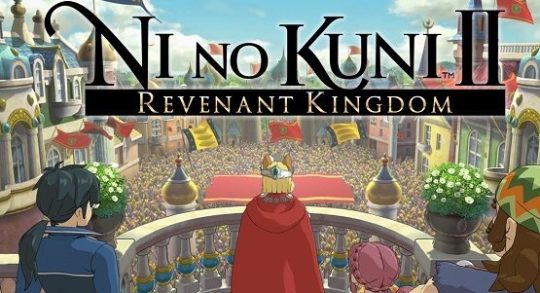
I played the final chapter of Ni No Kuni II: Revenant Kingdom hours after President Trump, a world leader cartoonish, short-sighted, and petty enough to fit fairly inconspicuously among the cast of villains in this storybook JRPG, announced and carried out an airstrike on Syria. As our country resigned itself to add fuel to the fire of one of the worst humanitarian crises in modern history, and risked upsetting its already tenuous relationship with other powerful nations, I helped the cat-eared boy king, Evan Pettiwhisker Tildrum, and his gang of eternal optimists, fulfill his mission of uniting the world under the banner of peace and happiness ever after.
As with many moments of this game, it should have felt cheap. To reduce the world’s ever-complicating and deepening evils of poverty, war, and power to something that can be resolved by the good-natured idealism of youth and a bit of combat that feels hardly more violent than a schoolyard scrap. And yet, I was moved. And it wasn’t the first time. This is a game that regularly turns saccharin, unrealistically tidy storytelling into genuinely affecting moments: moments that feel significant not just for their heart but almost urgently vital in their message. In our politically tumultuous age, where the burdens of inequity and violence feel heavy enough that predicting humanity’s imminent demise has become commonplace, Revenant Kingdom offers a balm equally aggressive in its dedication to locate and cultivate the goodness in everyone: the more ostensibly villainous the person in question, the more powerful the eventual redemption.
Since the game was obviously in production for a number of years, it’s unlikely the creators predicted our current placement on the doomsday clock at two minutes to midnight in the year it was released, but the opening scene begins with the collective nightmare scenario of 2018: the nuclear destruction of a city that looks conspicuously like New York. The president of this unnamed country, Roland Crane, is driving into the city as the detonation occurs, and he only has moments to witness the annihilation of his home and his people before he finds himself transported to a fantastical land, in the private chambers of the newly annointed young King Evan. After only moments of confusion, Roland seems to embrace the escape afforded by this mysterious event, helping Evan flee his own kingdom after his late father’s duplicitous advisor, Mausigner, stages a coup.
For long stretches of the game, Roland rarely mentions his destroyed homeland, but it’s a powerful enough opening image that the game doesn’t need to continually remind us of it - we know that Roland’s thoughts and actions must stem from his recent trauma, regardless of how shockingly good he is at hiding it. That image never left my mind during my roughly forty hours of play through Revenant Kingdom’s otherwise beautiful, charming, and whimsical world of entertainingly accented anthropomorphic denizens, just as it never leaves Roland’s. It’s an audaciously memorable way to stage the game’s ambitious anti-war themes.
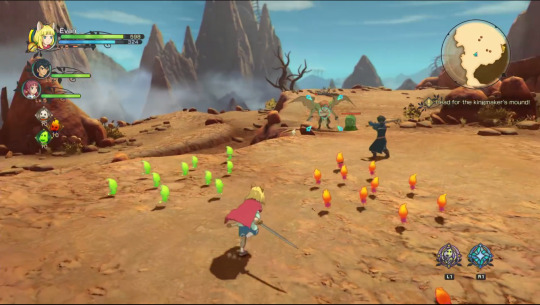
It’s also a sharp departure from the decidedly more personal story of the games predecessor, Ni No Kuni: Wrath of the White Witch. While that game, Level-5’s agreeable collaboration with Studio Ghibli, began with a similarly traumatic event - the death of the protagonist's mother - the stakes felt decidedly smaller. With Ghibli out of the picture this go around, Level-5 has maintained the original’s gorgeous, anime-inspired cell-shaded art style, and Joe Hisaishi once again turns in a fantastic score, but despite these aesthetic similarites, the gameplay of Revenant Kingdom is largely unrecognizable from its predecessor.
While White Witch had fairly standard turn-based, Pokemon-style combat, Revenant Kingdom is more action oriented, in the vain of something like Kingdom Hearts. Inventing combos of light and heavy attacks is fun enough, but the simple hacking and slashing at the heart of combat is complicated and balanced by a number of other systems, including dodging/rolling/jumping, “Higgledies” (little Pikmin-esque creatures that grant certain powers and spells during combat), and most importantly, the “Zing” effect. Every character can switch between three weapons freely during combat, each of which builds up a meter. Once that meter reaches 100%, that character can unleash a special move, anything from a devastating physical attack to an elemental spell. Keeping the Zing cycle going through combat is an actively engaging juggle, something that makes for rarely stale or repetitive combat. It helps that, also unlike White Witch, this game keeps grinding at a minimum, a trait that in comparison to most JRPGs feels surprisingly generous.
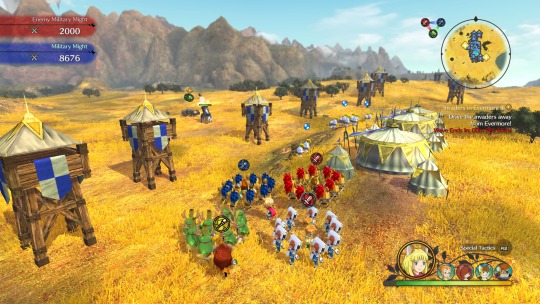
After Evan is ousted from his throne, he settles down in a relatively unoccupied territory where he builds a new kingdom from the ground up, which he names Evermore. This conceit introduces two other brand new systems that Revenant Kingdom employs, to varying degrees of success. One is a military combat mini-game called Skirmish battle, in which the player controls squads of soldiers as they face down enemy armies, such as rogue bandits intent on stealing his land. The combat here is automatic, with soldiers engaging each other on their own as soon as they’re close enough. Where the player comes in is in positioning and morale boosting - there’s a rock, paper scissors system in which sworded soldiers can easily best axed soldiers, axed soldiers beat speared, and spears beat swords. The player rotates these squads in positions that are most efficient, all the while ordering them to charge and defend at opportune moments. It’s a simple system, one that’s hardly a pain to engage with, and yet one I was rarely happy to have to do. There’s too little control over soldiers to make it much more than a mindless exercise, and there are sharp spikes in enemy levels that mean if you’re trying to complete all the side quests involving Skirmishes, you’ll have to do a decent amount of grinding. Thankfully, this is largely optional, and though you do have to be a certain level to complete sections of the main game, it never feels like too much.
What felt more at odds with my enjoyment in this system, though, outside of its exact mechanics, is its language and presentation, which just doesn’t seem to match the whole spirit of the game. Evan builds Evermore in the name of world peace - he wants to end war by bringing all nations of the world together. And yet, part of the game has him doing this by engaging in actual battle. The regular combat system feels more excusable for this, as you’re mostly fighting actual monsters or robots, and it feels primarily in the name of defense rather than offense. But that Evan is building a standing army of soldiers to wage war seems antithetical to the rest of the game. Even though it’s generally presented in a cutesy way, using the chibi character designs of the overworld, it’s a bit hard to reconcile.
One can similarly lob these criticisms at the very fact he maintains a monarchical structure in Evermore, but this is where the other new game system comes into play, which feels decidedly more thought out. The player gets to help build Evan’s new kingdom in a manner that doesn’t feel entirely removed from Metal Gear Solid V’s Mother Base building. You build new structures around the kingdom, from shops that help you develop new weapons, armor, spells and Higgledies, to bazaars, lumber yards, farms, and other services that earn you various resources, which can help with both crafting and with completing the game’s many side quests. To manage these places, you select citizens of your kingdom that are particularly suited to the task at hand. Engaging with the multiple menus of managing Evermore isn’t always fun - there’s a lack of intuitiveness in the layout that makes certain tasks more tedious and time consuming than they really ought to be. I hope that this is the kind of quality-of-life issue that could be fairly easily fixed in subsequent patches.
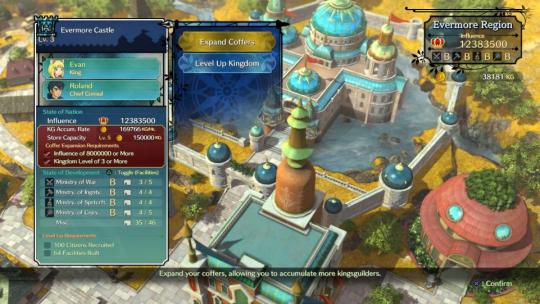
Citizens join your kingdom when you complete side quests, which usually involve doing some sort of favor for them before they agree to pack up and move. There can be a certain lack of imagination in the player tasks for side quests, which too often involve simple fetch or delivery quests. And yet, side quests are compelling for a number of reasons. First is that every time you gain a new citizen, it feels like a legitimate reward that allows you to move forward with a new project in Evermore. And between quick load times, multitudinous fast travel points scattered around the world map, and an airship that can get you just about anywhere within mere seconds, the pacing of these quests feels appropriately zippy in relation to the task at hand. It’s not difficult to knock out half a dozen side quests in the course of an hour, a time investment that feels more than worth the effort.
But most importantly, these quests allow you to engage with your subjects in a way that fascinatingly subverts the inherent power dynamics of your respective positions. No task is too small or demeaning for King Evan. Even when it feels like he really should have more important things to do, he faces delivering love letters or searching for missing personal items with the same enthusiasm and gravity of purpose as he does taking down a giant monster that threatens the safety of a city. This is a common discrepancy among open world games and RPGs such as this, the question of why someone burdened with such a weighty quest would waste his time helping someone with their menial, asinine shit. Rarely does this discrepancy feel so thoroughly justified as it does in Revenant Kingdom. Evan is a King that works for his people without a single thought as to what may or may not be beneath him. It’s not surprising that with such unwavering devotion, he so quickly gains such a strong following. Most of these many side characters are, in turn, funny and charming characters in their own right. Level-5 did an excellent job adding fun character and voice flourishes to the localization, and engaging in this dialogue is often its own reward, outside of whatever more tangible payments you receive.
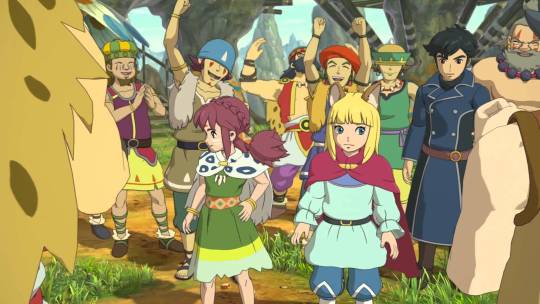
Most of the main cast of characters outside is also well done, particularly Evan and Roland, but also the burly sky pirate Batu, who is a blast to control in combat with his giant axes and hammers, and his fierce daughter Tani. Some of the characters introduced in the latter half of the game feel a bit more like afterthoughts than the core group, but are all serviceable enough. A particularly delightful character is Evan’s Kingmaker, Lofty. All kings in this world are blessed with essentially the divine right to rule by virtue of the bonds they make with Kingmakers: towering, elegant beasts who grant their Kings with legitimacy and defend their kingdoms. Evan had one back in his home kingdom of Ding Dong Dell (just one of the many delightfully titled proper nouns to be enjoyed in this game), but once ousted, he has to go through a ceremony to get a new one for Evermore, and ends up with Lofty, a tiny, deformed-Lisa Simpson looking creature who speaks with a thick Welsh accent and the more universal dialect of sarcasm. His dialogue, like that of Drippy’s from the previous game, is one of Revenant Kingdom’s true joys.
Added to the mix is a cast of villains that make for fairly obvious, but overall successful social commentary. There’s a corrupt king who rigs the luck-based legal system of his government to ensure he always comes out on top, a secretive ruler who enforces draconian laws on her citizens, a tech-wizard CEO whose corporation has become so large it’s merged with the government and works its labor force to death, and most compellingly, Mausinger, the one who dethroned Evan. Being young and kept in the dark while he was at Ding Dong Dell, Evan was ignorant to the racial inequities of his kingdom, where humans and cat people forcibly kept economic and political power from mouse and rat people, which formed the basis for Mausinger’s coup. Evan’s reckoning with the evils of his home kingdom is one of the more fascinating story threads in the game, one I was pleasantly surprised to see delved into.
It’s one of the many moments where Revenant Kingdom eschews the black-and-white morality of most JRPGs, while nevertheless leaving questions of who the heroes are and who the villains are decidedly unambiguous. Goodness, the game implies, is the potential for improving, for recognizing one's mistakes, no matter how well-intentioned they may have been, and vowing to do better. This is a universal, all-powerful concept in the world of this game. It may be intentionally reductive, a childishly and fantastically simple solution to humanity’s history of injustice, but the message rings shockingly true. Maybe in a more nuanced age of history, that truthfulness might have felt just a bit hollow, but the bluntness of it lends it a quality that for 2018, feels critical. It’s the militantly good-willed, all-out assault of optimism that we could really all use right now.
8.7
#Ni No Kuni II: Revenant Kingdom#ni no kuni#video games#anime#JRPG#RPG#Open World#Politics#Donald Trump#pop culture#review#criticism#podcast#games
9 notes
·
View notes
Note
So you read "Scrooge's Wedding" how was it? How were the characters? How did they act toward the situation?
Oh boy, oh boy! Okay here goes!
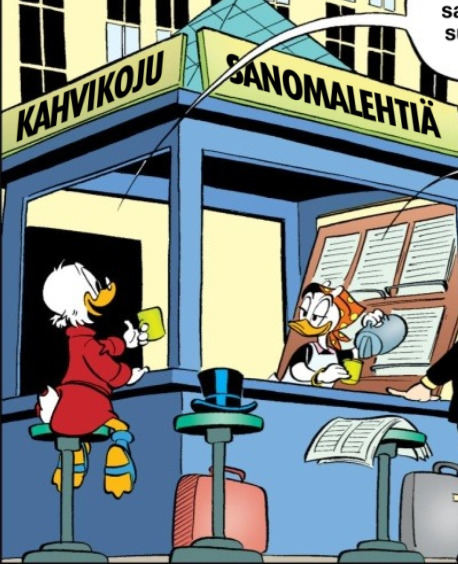
We open up with Scrooge enjoying his morning coffee and magazine with this old lady who generously lets him drink almost free.he does bring his own mug with him and everything. Also,they are more or less friends. The coffee-lady points out that there has been an expose written of Scrooge and his scandalous lover affair of the past. No, not the one you are all thinking. This one is way more...teenagey.
(This turned so long, that I am putting the rest under a link.)
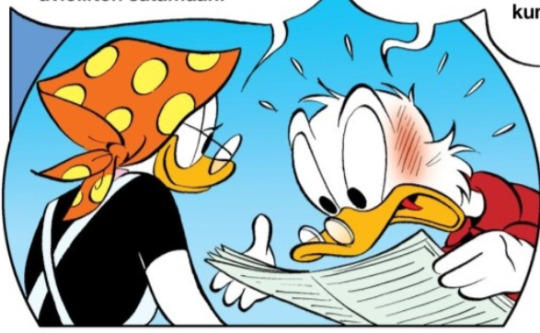
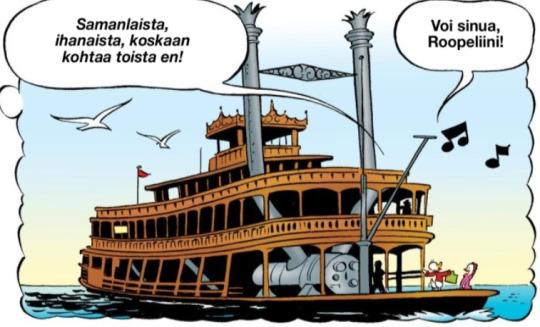
So Scrooge during his Mississippi years met a girl named Clementine, and was smitten. He proposed and Clementine said yes. The two were all ready to sail to their wedding and live happily ever after. Now, we don’t know if this story follows the Don Rosa timeline, but if it does...Scrooge would have been somewhere between 13-15 when this took place. That’s...not an ideal age to decide on your life-partner, but I can also buy that a teenager of that age would think that it was the best idea ever. C’mon guys, he is totally an adult, he has a job and everything. It has to be tru luuuuv...(hormones, what hormones, this is the 19th century, never heard of them!) Scrooge also wrote a goddamn embarrassing song to Clementine, and it is awful and so, so teenage!

But it was not to be, as the ship sunk and Clementine went MIA in the aftermath.
jump to the present day, and the fact that Clementine was never proven to have died, has sent every hopeful gold-digger to Scrooge’s side to claim to be his long lost girlfriend, and hey could we maybe get married now!

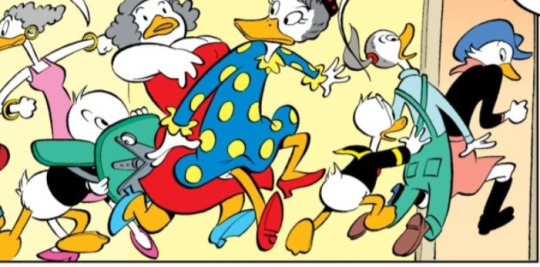

And Scrooge’s friends and family have to physically fight them off. Look at miss. Quakerfaster, she is fierce, and deserves a raise.
None of this would be more than a passing nuisance, if it weren’t for one particularly persistent suitor, who claims to have the ring that Scrooge proposed Clementine with, and is willing to sue Scrooge for billion$ for breaking his promise.
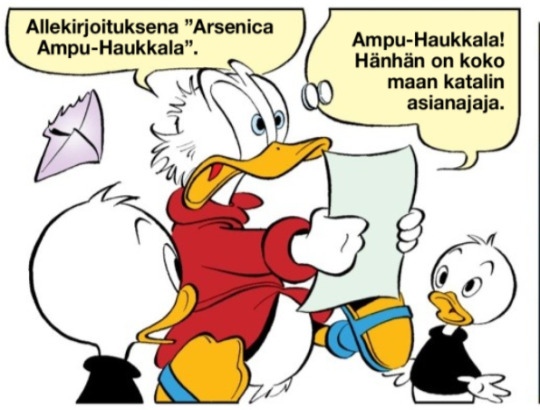
This Arsenica is a lawyer known for bending the law as far it can bend without snapping. Unknown to the public, she also has a criminal past in Mississippi.

She and her partner caused the accident that where the real Clementine went missing, and also stole everything that was in the ship’s safe. Including the ring.
Arsenica takes Scrooge to the court, and apparently in the duck verse you can actually sue someone for not marrying you, as the ring is seen to be enough evidence that Scrooge better start coughing up those billion$
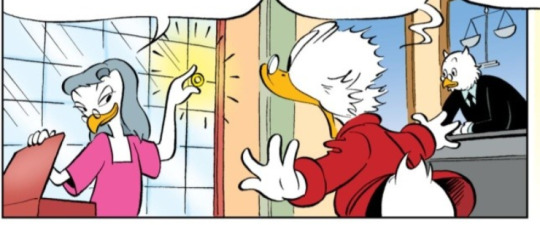
But wait! That’s not all. Arsenica pulls some centuries old law from the archives of Clementines old hometown, which states that a proposal once made is legally binding. So now Scrooge is legally required to marry Arsenica, no matter if he wants it or not.
I...um. I do not think that that is how law works. But okay, it is supposed to be shady as fuck. We already know that Arsenica has used her connections to rig the whole system so Scrooge has no change.
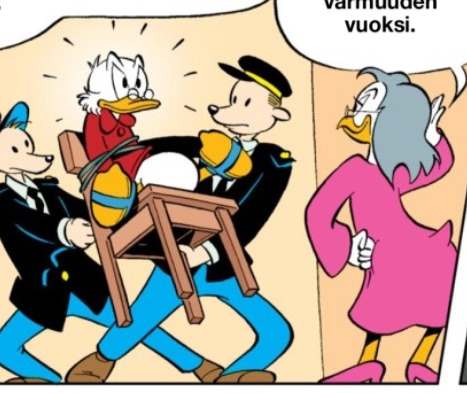
Those police officers know that they are not upholding the justice anymore. Look at their faces.
Meanwhile Donald is digging information in Clementine’s old hometown too, and finds out that Clementine did not die in the accident. She was found and nursed to health, and afterwards decided to start a new life with new identity. Why? Why not. Good for you girl, living in the hyper-patriarchal era and deciding to become an free spirit instead. This does not help Donald, who still cannot prove that Arsenica isn’t Clementine.
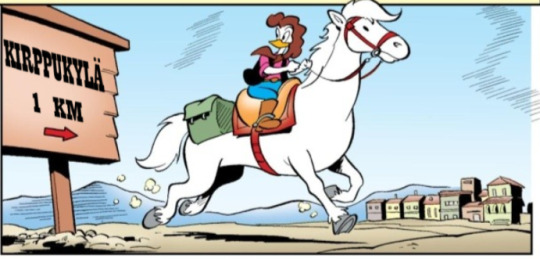
And when the day of the wedding arrives, well whoo-boy has no city ever been happier to witness a forced wedding than Clementine’s old hometown!
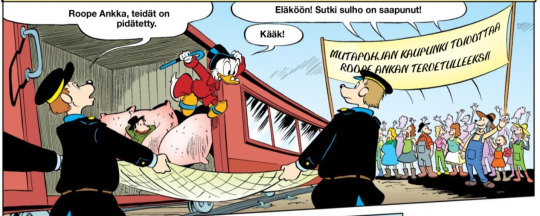
Sure, they know that the world’s richest duck is being married of against his will to someone who clearly is only after his wealth, but this is also the only public thing that has ever happened in their town. Hell yes they will make a banner!
But Donald and the boys are not giving up. The boys, for um..reasons, decide to go to that coffee-lady in Duckburg and try to recruit her to pretend to be the real Clementine, because at least she is Scrooge’s friend and about the same age.
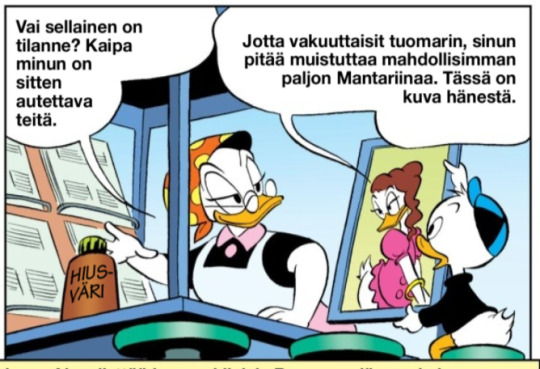
Donald on the other hand is trying to start a citizen’s initiative for overturning the law that allows forced marriages. Everybody give a round of applause for the most reasonable plan in this entire comic.
What follows is the opposite of reasonable, and the point where this comic takes a sharp turn from quite reasonable and believable to straight up What?
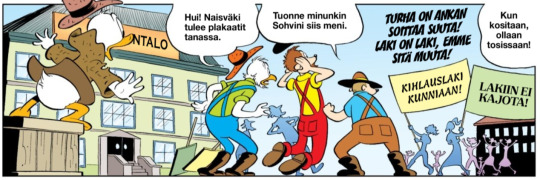
Because this women’s organization will have none of that consensual marriage bullshit. These women know that literally the only way to get a man to stand in front of an altar is to physically force them. You know what is the biggest feminist issue of our age. Income inequality? Fuck no. industrialized female sexual harassment. What a joker you are. No. The biggest feminist issue that will rally literally every woman of this city is how men are always throwing proposals around and never following through with them. Yes. That one.
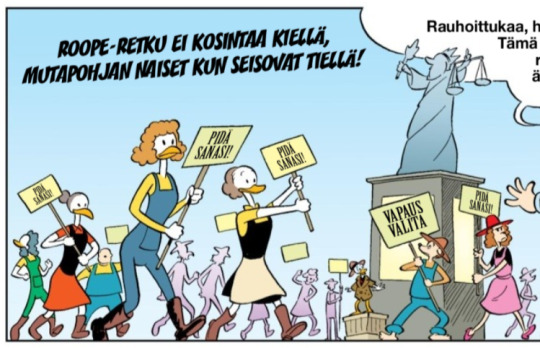
What?
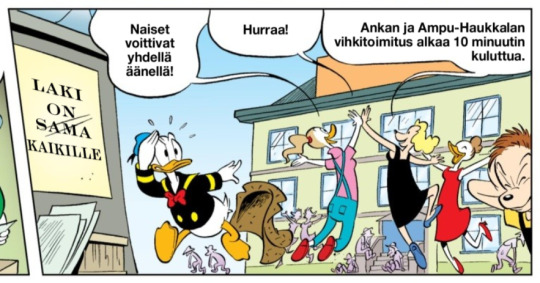
The issue goes to vote, and the narration helpfully tells us that the men lost. Because Clementine’s hometown has an exact same amount of men and women, and one of the men didn’t come to vote, so the marriage law was legalized. Wow I really hope that none of these women’s stupid teenage children happen to get drunk and propose a drug dealer, or they will be legally forced to follow through!
So the wedding takes place.
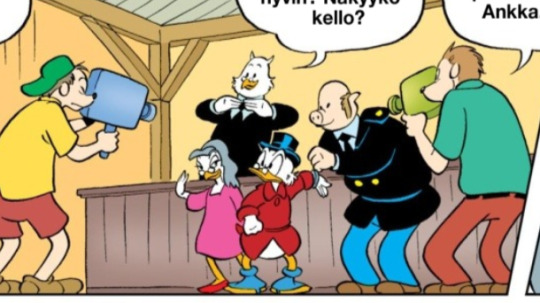
that is exactly what we want our town to be remembered for. We once handcuffed the richest man in the world to our police officer and then forced him to get married.
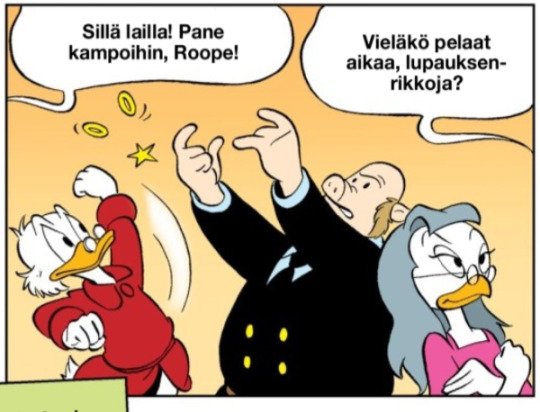
Scrooge physically fights against the marriage, this doesn’t help. The boys try to pass the coffee-lady as the real Clementine, but this doesn’t help either.
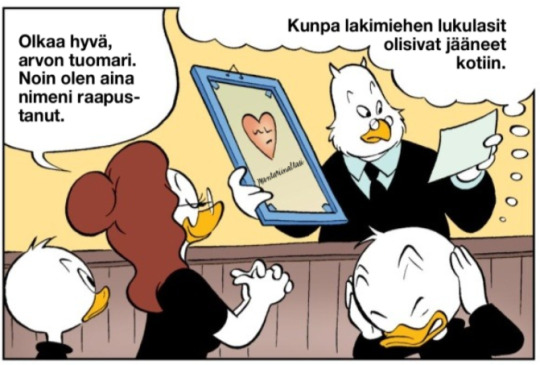
The judge will see this marriage happen if Scrooge has to be restrained for it. Notice that Scrooge does not say the words “I do” but the judge still cheerfully pronounces them husband and wife.
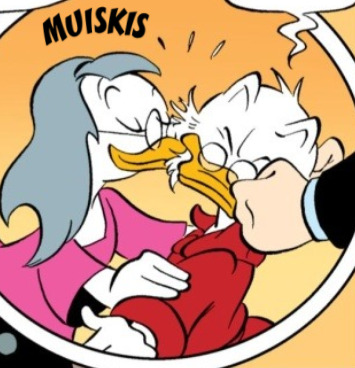
But new Mrs. McDuck isn’t allowed to keep her title for long. Donald barrels in like the true hero that he is.
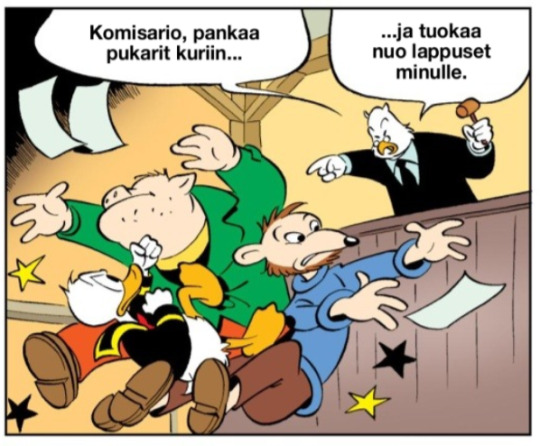
He has found old papers that prove that Clementine’s ring was stolen, so clearly the real Clementine could not have the ring. Finally the people in here take their collective heads out of their asses and call the police. Arsenica is proven to be the thief that blew up the ship and stole all the goods from it.
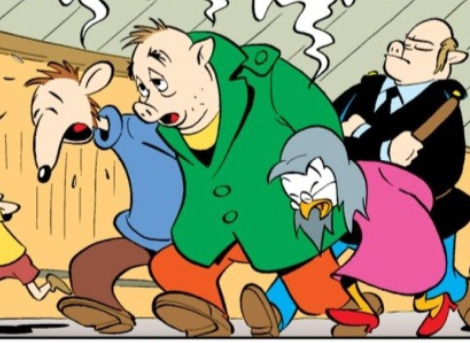
Then it is also, le gasp, revealed that the Duckburgian coffee-lady was the real Clementine all along!
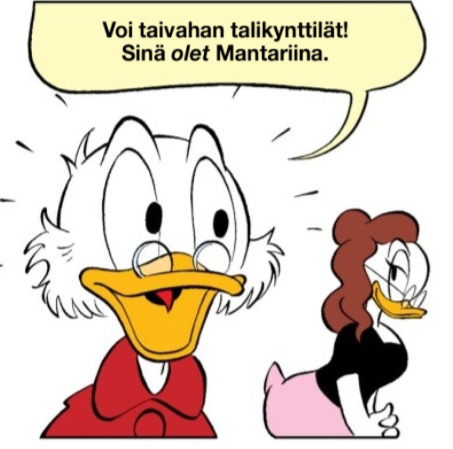
They prove it, because the real Clementine remembers all those stupid-ass songs and embarrassing nicknames they gave each other when they were in love. And yes, those were some nuclear level grince-worthy songs. You just know that it is going straight to youtube. That smartphone recorder is probably live-streaming this.
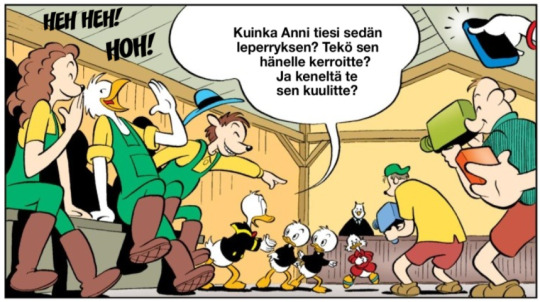
There is a tense moment when the judge asks whether the real Clementine wants to use her right to marry Scrooge and become the new Mrs. Richest duck in the world.
She doesn’t.
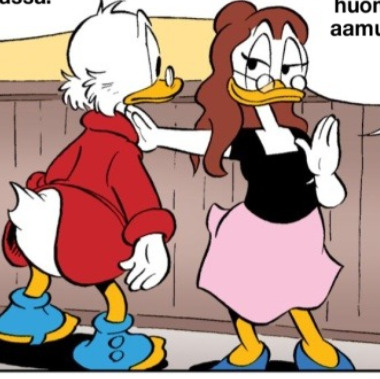
But she hopes that they keep building their friendship and that Scrooge better keep coming to her for coffee, she would be sad to lose his morning visits. And then they do exactly that, Clementine keeping doing her thing and Scrooge even embracing his god-awful songs in an ironic inside joke kind of way.
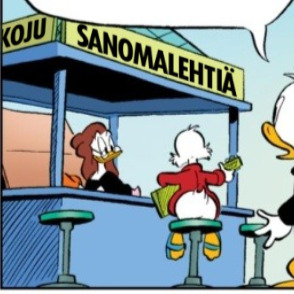
You know, I was kind of meh about this story, but now writing about it, I’ve grown to really like it. Scrooge and Clementine are the kind of sassy old people I could see having a really fun friendship.
55 notes
·
View notes
Text
Hyperallergic: What Planned Parenthood Looked Like in the 1940s
Cover of “The Solider Takes a Wife,” a pamphlet published in 1946 (all images courtesy New York Academy of Medicine Library)
After fighting in World War II, American soldiers coming home faced another duty of sorts to their country: get happily married, have a baby, and nurture a stable, healthy family. Among those encouraging that wartime effort was Planned Parenthood Federation of America (PPFA). The birth control organization published illustrated pamphlets aimed at veterans as well as women that provided firm, authoritative guidance on how to best prepare to start a family. They gave them titles like “The Soldier Takes a Wife” and “For the Man who comes back — and for all his generation,” and included quizzes in their pages such as, “As a prospective mother — what’s your score?”
Cover of “Planning to Have a Baby?”, a pamphlet published in 1946
Librarians at New York Academy of Medicine recently found examples of these illuminating documents in their archives, coinciding with a free lecture series it’s hosting with the Museum of the City of New York titled, “Who Controls Women’s Health? A Century of Struggle.” Notably, this dated literature emerged right at the time when the Federation had undergone a critical rebranding. Originally known as the American Birth Control League (ABCL), it adopted, in 1942, the gentler-sounding name of “Planned Parenthood.”
While the movement continued to champion older ABCL principles (including Margaret Sanger’s support of eugenics), it also became much more family-centered, arguing that strategic family planning was part of the nation’s commitment to a healthy and strong society. As one pamphlet from the 1940s claims, “The fact remains that having a baby is still the most important single event in any woman’s life — important to herself and her husband and to the future of her country.” The role of birth control was to ensure this event would happen properly, and at the optimal time.
As Dr. Lauren Thompson, an assistant professor of history at Kennesaw State University (and author of forthcoming book Battle for Birth Control: Mary Dennett, Margaret Sanger, and the Rivalry that Shaped a Movement), told Hyperallergic, the renaming “was stressing an apolitical stance, one that deemphasized the radical, feminist origins of the birth control movement, and instead focused on the idea of strengthening families overall, and incorporating family planning programming into the state’s broader social initiatives.”
The pamphlets laid out these plans clearly, often accompanied with endearing pictures of a nuclear family. “The soldier takes a wife” features illustrations by cartoonist Ralph Stein of young dads in military uniform, shown holding a bride, pushing a stroller, and attempting to quell a screaming baby. The text, too, can be playful: fictional anecdotes spelling out the woes of one “‘Flash’ Edwards” and one “‘Steady’ Steve” serve as cautions to those who don’t space their children, figure out their budgets, or have a permanent job before starting a family.
“Getting married and having a family is like a military campaign,” the pamphlet declares. “It takes forethought, preparation and a certain amount of strategy.”
Pages from “The Soldier Takes a Wife”
Although these pamphlets did stress that both parents share the responsibility of preparing for and caring for a child, challenging discriminatory gender roles within the family was certainly not Planned Parenthood’s primary agenda at the time. Rather than that of an independent woman, the ideal lifestyle they advocated saw marriage as the center of society.
“They were not interested in discussing how women’s use of birth control could help them achieve personal freedom,” Thompson said. “Although PPFA did discuss women’s sexual satisfaction in their literature, they did this from the point of view of marriage only. A happy wife — sexually satisfied by her husband — would be the key, in turn, to a strong family and a strong nation.”
Indeed, one pamphlet describes healthy, safe childbirth as “the most important single job of your life.” It also dictates that women hoping to be mothers first consult their husbands and their doctors, and also maintain a strict daily diet (which includes the note, “three or four cigarettes a day are enough for a pregnant woman”). And there’s the handy tip that a maternity corset or brassier can help you “regain your figure after the baby arrives.”
Pages from “Planning to Have a Baby?”
Intended for mostly white Protestant readership made of liberal professionals and those of the upper class and the established medical world, these pamphlets were also a way for Planned Parenthood to easily distribute medical advice, as it does today. But again, health concerns were spelled out in relation to successful childbirth, with sections describing diseases or ailments that would require postponing a baby. Notably, abortion is described on one page as “the desperate alternative to planned parenthood.” On the other hand, contraception was the solution for the virtuous — Planned Parenthood even published approving scripts for ministers who were offering marriage counsel to young couples. Much as it promoted happy and healthy futures, birth control at this time also kept a woman in place in the domestic sphere, as part of a male-dominated structure, where she was urged to be both wife and mom.
As one pamphlet cheerfully summed up: “America needs more healthy babies, so have as many as you can. Healthy, love babies bring more happiness than any other possession.”
Pages from “For the Man who comes back — and for all his generation” (1945)
Page from “Planning to Have a Baby?”
Page from “Planning to Have a Baby?”
Pages from “The Soldier Takes a Wife”
The final talk in the series, More than Medicine: Social Justice and Feminist Movements for Health, presented by historian Jennifer Nelson, takes place at the New York Academy of Medicine (1216 Fifth Avenue at 103rd Street, East Harlem, Manhattan) on October 5.
The post What Planned Parenthood Looked Like in the 1940s appeared first on Hyperallergic.
from Hyperallergic http://ift.tt/2fV8ACa via IFTTT
1 note
·
View note
Text
Biodiversity Everywhere, For Everyone!
Hey everyone! This week we have a lot of info to cram in so summaries are going to be brief and sparse. Also a quick note about the past two blog entries; I had read the syllabus wrong so their content is a little off what it’s supposed to match, so chapter two won’t be included in this week(because it was already covered), but starting with this week we’re back on track, woohoo! Now, let’s get to it.
Figure 1. Biodiversity Hotspots.

Chapter four is all about biodiversity and evolution. Species evolve over long periods of time (Tens of thousands to even millions of years!) in order to adapt to their environment or overcome a new environmental challenge that the species had not had to face yet. Humans were particularly good at evolving useful traits, and some scientists might say we have developed one of the most useful tools in evolutionary nature: opposable thumbs. They allowed us to build tools to hunt and start fires that snowballed into the civilization we have today. One of the concepts they discuss in this chapter is the idea of species richness and species evenness. Species richness is about the different kinds of species living in one area, the more species the more species richness the area is said to have. Rainforests tend to be very species rich due to their high levels of biodiversity. Species evenness doesn’t depend on how many species are present, but rather how many of each species there are. Areas where there are even numbers of all of their species are even have more species evenness than areas that are dominated by one or more species over others. In order to memorize this concept I like to think about the freshmen dorms here at Fordham. For instance, Alumni Court South would have a lot of species richness (if we count types of students as different species for the sake of this example) because there are so many different types of students there: athletes, nerds, theatre kids, try hards, film buffs, hipsters, wanna be social media influencers, etc. etc. It’s really a conglomeration of different species, like a real ecosystem. While ACS would be high in species richness, the overwhelming amount of football players that live in the basement makes it not very high in species evenness. Loyola Hall on the other hand, tends to attract only a specific type of student i.e. the honor students. In order to live in Loyola you have to be an honors student. This means that Loyola is low in species richness, but very high in species evenness as all of the students who live there are the same “species”. If there were ever a shortage of food, the football players in the basement of south would probably win over the rest of us because they’re gonna hog all the food, but I’d hate to admit that freshman football players could potentially be more evolutionary advanced than I am. One additional side note I’d like to add from this chapter is about every bronxite’s favorite pest: cockroaches! Often referred to as nature’s ultimate survivors because they can survive nuclear radiation, but all it takes to kill them is hot water and hand soap! Take that you nasty dinosaur bug things.
As we move on to chapter five we keep the ideas of biodiversity with us but this time look at how different species interact with each other, and how each of these interactions is key in maintaining an ecosystem. The textbook tells us that there are five different interactions to be had in the animal kingdom. They are: interspecific competition, predation, parasitism, mutualism, and commensalism. Interspecific competition occurs when members of different species interact to compete for the same resources, an example of this would be many different animals gathering at a watering hole. Predation is probably the most thought of interaction in the animal kingdom and is composed of a predator and their prey. The predator eats the prey and while it may not seem like a great situation for the prey, this exchange is helpful to both species as well as an ecosystem as a whole. Parasitism occurs when one organism (the parasite) feeds off another organism (the host) usually by living on or inside the host. An example of this could be a tape worm living inside an animals stomach, but I think a better example might be my brother who graduated two years ago and is still living at home with my parents who pay for just about everything he does (get a freaking job already, Jack!!!). Mutualism is an interaction that happens between two different species but both of them benefit from it mutually. This is one of my favorite pairings in the animal kingdom for one example alone: the crocodile and the plover bird. Plover birds are small birds that work in tandem with crocodiles to receive food. After crocodiles are done with a meal, they open their huge mouths and let the plover bird pick their teeth. The bird gets fed, and the crocodile gets a clean mouth- everyone’s happy (I just think it’s adorable that these birds are essentially crocodile toothpicks/brushes)! My mom likes to pretend that my brother living at home is an example of mutualism because he cleans and helps around the house every once in awhile, but I know he’s being a parasite, trust me. Finally, commensalism is an interaction that is beneficial to one organism, but has virtually no effect on another. An example of this would be the remora fish and sharks. Remora fish have special suckers attached to its fins that let it hook on to other animals like sharks. The remoras then get to use the shark as free transportation and protection from its predators. All of these interactions feed into another concept in this chapter, which is population control. Environments have to have protections from allowing one species to grow/shrink out of control, and an imbalance in this relationship can cause stress on a whole ecosystem. For instance, in a study done by the University of Washington’s School of Environmental and Forest Sciences they found that when wolves did not have enough room to roam, they were not able to control the population of coyotes (a common prey for the wolves). The population of the coyote’s started to increase as the area the wolves had to roam was cut down thanks to human activities. This could in turn cause other animal populations, like deer for instance; to decrease because now they have more coyote’s hunting them and the same amount of wolves in a smaller space. Obviously not ideal for the deer.
Before we move onto the next chapter there’s one other thing I want to discuss and that was one of the critical thinking questions posed by the book: What is an example of environmental resistance that humans have not been able to overcome? This question struck me because I had a hard time trying to come up with an answer. My only thought is something like a disease or cancer that we do not have a cure to yet. I feel as if humans have been particularly destructive whenever there’s an environmental obstacle they need to overcome, so there is not much left for us to conquer, but I could be very much mistaken (and honestly I hope I am)! In this next chapter we move onto another factor that influences biodiversity, which is climate. Climate can be simplified to the idea of weather in a given area over time. Instead of regurgitating from the textbooks we can use what we know for this! One of the main causes of global warming comes from harmful emissions of gases that are depleting the ozone layer, like CO2. Here are some of the effects CO2 has on the environment:
-More frequent extreme weather (very very hot days and very very cold days instead of normal temperatures)
-Decreased snow cover
-Increased ocean levels
-Increased climate variability
-Increased ocean acidification.
All of these pose threats to biodiversity on Earth because some plants and animals can only survive in certain climates, so with the climate changing so frequently it would be harder for them to survive and thus decrease biodiversity all over the world.
Word Count: 1,383 Class Question: What is an example of environmental resistance that humans have not been able to overcome?
Works Cited
Butler, R. A. (2005, August 18). Biodiversity Hotspots [Digital image].
Hoffman, A. (2017, November 23). Climate change and biodiversity. Retrieved from https://www.science.org.au/curious/earth-environment/climate-change-and-biodiversity
0 notes
Text
Y and Z
Do you guys remember when analysts, insiders, and marketers were trying to “crack” the Millennials (Gen Y)? It wasn’t even that long ago when articles on figuring out how to connect with my generation were vogue. My dad even attended a conference on how to integrate Millennials into the workforce, circa 2010. It still happens from time to time, but now, things are shifting towards figuring out my successor, Gen Z. Makes sense, I guess, considering they’re almost as large as the Millennials and the Boomers, and despite the oldest members being 21 (born in 1996), people haven’t really been looking at the differences between those my age and those born a decade later, largely because they’ve often been lumped in with Millennials.
I’m towards the tail end of the Millennials (born in ‘93), and so I have some friends that are at the beginning of Gen Z, but overall, my friends tend to be Millennials, both younger and older. In some regards, I find more similarities with early Gen Z members than older Millennials, but altogether, I’d say my affinities are definitely more with the Millennials than Gen Z. That’s not a slight against Gen Z, rather just a noted difference, which will probably become blurred as we all get older anyways. Going back to school well past when most people do also puts into perspective a bit of the difference; many of my classmates in first year courses were fresh outta high school (born in ‘98) and it does make me wonder where things are headed as Gen Z grows and matures, and where the generation follows it takes us as a society.
With the Millennials, Boomers and Gen Xers had to learn how to professionally work with a generation that grew up with the Internet in its infancy, with a generation that was given so much from its parents, including growing up being told we’re each our own “special snowflake” and that we should reach for the stars, and so long as we got a degree -- any degree -- we’d be happy. We were considered idealistic, liberal, and tech-savvy.
Well, now, everyone’s used to it, and perhaps because Gen Z is also very tech-savvy and educated and grew up being given participation ribbons, nobody sought out the difference until more recently. But there are differences. Gen Z is more conservative apparently (I don’t see it in terms of social issues), more into “branding” oneself and generally more consumerist. Gen Z is also way more immersed in digital technology than I ever was growing up. I remember into junior high knowing people who still didn’t have Internet or a cell phone; I can’t see that really happening now except in extreme scenarios. Furthermore, they grew up with high speed internet, not that dial up shit I had.
I’m still one to prefer browsing on a stationary, desktop computer, rather than on my phone. The phone is often more handy when I’m out, but if I have a choice, I’ll always go for the computer. Which is partly why I loathe mobile-specific social media for not being more browser-friendly. Being a photographer is no doubt an influence here, as I like being able to view visual media on a larger screen. But I also grew up with desktops, and was used to having to physically go home to chat with people on MSN, and when I was out, I was basically disconnected. I had a cell phone, sure, but I wasn’t texting on it (which was expensive) or browsing the ‘Net on it (which was even more expensive). None of that happened until I got a Blackberry in 12th grade. Millennials grew up around the PC; Generation Z grew up around iPads and iPhones. Apparently, on average, Generation Z does not value time offline, while I personally value being disconnected on occasion (not permanently -- I’m not that much of a luddite). I know when I’ve spent too much time in front of screens.
Gen Z is also more visual. Well, I’m a photographer, so I’m naturally a very visual person, so this works for me on some level. And as a Millennial, I’m not unaware of short attention spans among my cohort. As digital technology continues to make inroads, it only makes sense that attention spans continue to wane. But even still, I’m here, writing long blog posts and I enjoy photoblogs which are more long-form as well. They aren’t easily digestable, though, which is why there are less viewers. It makes sense that social media, then, has moved towards less politicized, more mobile and visually-orientated platforms like Snapchat and Instagram, while Facebook, Twitter, and Tumblr are waning, especially among Gen Z. I’m not too happy about that, to be honest. I find value in political discourse and believe that if we don’t fight for rights we may as well not have them. You’re not getting discourse if you’re busy posting aesthetic selfies on Snapchat. It seems like youth (including Millennials) have kinda accepted things as they are, and, perhaps due to overstimulation, are a bit fatigued at all the information out there, and so there is a certain sense of complacency. The general mood of memes seems to be “yeah, the world is shit, I’ve accepted it doesn’t make sense and therefore I’m gonna shitpost rather than do anything about it.” Maybe I’m reading into it too much but I’ve seen others corroborate this mindset. It’s quite a different mentality from 7 years ago, when Twitter was at peak, which is all about discourse, often political. I don’t think the interface of many websites now helps, which bombard you with ads and offers before you can see anything.
It’s a bit early to say, as the youngest Gen Zers are between 0 and 7, depending on who you ask, but I hope one thing that Gen Z and its parents (mostly Gen X) learn from the Millennials is regarding education. It seems like the eldest members of Z were brought up with the same ideas as us, though. I hope that they realize that it is important still to follow what you’re passionate about and you do need to find something of a career that you will enjoy, but I hope that there is more of a practicality about it. My generation was told we’d be set as long as we had a degree -- any degree -- and I can tell you that that simply isn’t the case. It isn’t that there are “worthless” degrees, but that there are degrees which require you to market yourself harder than if you got an Engineering degree and then becoming an Engineer. I already know a few older Millennials who went down that path, and are or have gone back to school later for something more practical yet still enjoyable. Academia works for certain fields, certainly, and the program I’m in is practical, but we’ve flooded universities too much because we’ve imbibed the idea that we need a degree to succeed, which is utter poppycock. A lot of people in university would be better suited to a technical school or a diploma of some sort, which often yield great success without having to pay back a mountain of student loans. I don’t know if Gen Z will learn this, as I know parents of Gen Z kids who’ve really imbibed the post-secondary ideal as much, if not more, than the Millennial’s parents.
I guess if you’re reading between the lines, I’m a bit sardonic about the future. It’s nothing to do with Millennials or Gen Z specifically, as we’re both products of the time we grew up in. A friend of mine joked that I was “born too late” and, considering how slow I sometimes I am with accepting technological trends and how much I like late 20th century pop culture, maybe he’s got a point. But it’s always easy to romanticize the past. The ‘50s were great, if you don’t factor in how close we were to nuclear annihilation or how discriminatory the hegemony was. Furthermore, I’ve definitely become far more aware of things due to being able to access the Internet than if I grew up in an earlier time. Despite the overstimulation, I think we can take for granted how much more aware we are able to be now; friction of distance has been reduced to rubble. Also, my earlier comments about Gen Z favouring visual, favouring mobile, really apply to us all. Millennials have orientated towards these formats, as well as older generations. It definitely seems like my grandparents are more into their smartphone than they ever were Windows 98. It’s just Gen Z is the generation that has no basis of comparison to a pre-mobile era, just like Millennials can’t compare to a pre-Internet age (except maybe some of our eldest members), and both have an influence on their respective generation.
Still, I’m not only curious how I’ll survive progress, but how society will as a whole. America is in late empire, and there is no new Western power to take the helm like after Britain. It’ll be interesting how that plays out for still-maturing Western countries like Canada, Australia, and New Zealand, but it seems like we’re shifting to a pre-Columbian paradigm dominated by the East. As with any change, there’s uncertainty, although America will likely remain a major player in geopolitics for the long term, even if less hegemonic in scope. I’m even more curious about what will become of us once those degrees we hammered thousands upon thousands of dollars on are rendered obsolete by AI. Some say the singularity is nigh, some say it already happened and we were too busy tweeting to notice. But I don’t think it has happened in the Kurzweilian sense, and once that happens, it’ll be interesting to see where things go. If we can “survive” it, we’ll probably be better off. But then there’s still climate change. Maybe once we become a (hypothetical) Kardashev Type 1 civilization, we’ll have progressed towards not killing ourselves over differences and will have finally survived progress.
But for now, I still have to live in a world ruled by filters and brands, all-the-while we became increasingly connected yet disconnected. Maybe I’ll fuck off to Dawson City before having to bear the full front of our digital future. Sounds nicer for someone unwilling to embrace digital advances like so many of my peers. Then again, how different, really, is seeing a bunch of people, disparately glued to their phones, from seeing a different bunch of people glued to their books. Despite being social animals, we’ve long desired our own “space” and privacy, at least in the Western world.
11 notes
·
View notes
Text
CBD Oil Canada By: Pickles Osiris
What Is CBD Oil in Canada?
CBD oil in Canada is made by extracting CBD from the whole cannabis plane. Next dilute it with a carrier oil such as coconut oil or hemp seed oil. Hemp seed oil, as the name suggests, is extracted from the seeds of hemp. However, only the flowers, stems, stalks, and leaves of hemp produce CBD extract. On the other hand the seeds themselves do not produce CBD extract. Although hemp seed oil is great to use as a carrier oil, it does not promote the same kind of benefits as CBD oil. However, what hemp seed oil lacks in cannabinoids, it definitely makes up for in other ways. Hemp seed oil is a great source of omega-6 and omega-3 fatty acids which makes it an ideal carrier oil.
Is CBD oil in Canada like THC?
THC is the main psychoactive cannabinoid found in the cannabis plant.It also causes the sensation of getting ‘high’ that’s associated with marijuana. However, unlike THC, CBD is not psychoactive. This quality makes CBD an amazing choice for people looking for relief without the mind altering effects of THC or certain pharmaceuticals drugs.
How does CBD work?
CBD is on of the many cannabinoids found in the cannabis plant also known as Cannabis Sativa. Cannabidiol (CBD) is incredibly multifaceted in that it can produce many effects through multiple molecular pathways. Scientific literature has identified more than 65 molecular targets of CBD. Although CBD doesn’t have an affinity for either of the cannabinoid receptors (CB1 and CB2), cannabidiol can regulate several non cannabinoid receptors and ion channels. Just a few of these receptors are the serotonin receptors, vanniloid receptors, orphan receptors (GRP55), and nuclear receptors (PPAR5).
How To Consume CBD Oil
If you are interested in taking CBD oil for the first time, you are going to have some questions. Do you smoke it? Can you cook with it? Can it be consumed orally? The answer to these questions are YES!
CBD oil in Canada comes in many different forms and the main three ways to take CBD oil are orally, topical application, or as an inhalant.
WAYS TO CONSUME CBD OIL
1. Consume CBD Oil Orally
If you have never vaped or taken CBD oil before then I definitely recommend starting with ingesting it. The easiest form of consumption is capsules and pills. Especially as the capsules can be filled with CBD oil to make ingestion quick and easy. Similarly with over the counter pills it will be easy to monitor your dosage. Also you won’t have to taste the oil. If the taste doesn’t bug you then feel free to also just take the CBD oil straight or on some chocolate.
via GIPHY
via GIPHY
2. Infuse With Food
The most fun, and by far the most delicious, way of consuming CBD oil is to infuse your meal. Specifically with butter, oil, and mixed with beverages. While orally ingesting is the most beginner friendly method, it can take longer for your digestive tract to absorb the oil. However once the CBD does kick in the effects are long lasting.
3. Take It Topically
Another great option is a topical application. Topical applications can come in balms, creams, lotions, butters and more. These are all great choices for sore joints and sore muscles as the CBD oil will help to reduce inflammation so you can feel more you.
4. Inhaling CBD Oil
Finally we have inhalation, if you already vape then this is a perfect choice for you. CBD oil can be used as an e-juice for easy on the go medicating.
BENEFITS OF CBD OIL
CBD oil is quickly gaining momentum in the health and wellness world. Scientific studies confirm it may help treat a variety of ailments like chronic pain, anxiety, and Crohn’s disease just to name a few.
Pain Relief
CBD is truly a miracle when it comes to pain relief and pain management. CBD can help ease spasms in people with Multiple Sclerosis (MS), and autoimmune disease that affects the entire body through the nerves and brain. A study involving rats with arthritis, in the European Journal of Pain, has shown CBD, when applied in a topical gel for 4 days significantly decreases inflammation and signs of pain without and added side effects.
Treats Anxiety and Depression
Anxiety and depression are two of the most common mental disorders. Specifically they can have devastating impacts on both your mental health as well as your physical well being. According to the World Health Organization, depression is the single largest contributor to disability worldwide with anxiety being ranked sixth.
However, many pharmaceutical drugs that are prescribed for both anxiety and depression can cause a number of side effects. In detail these include but are not limited to: drowsiness, agitation, insomnia, sexual dysfunction, headaches, lethargy, blurry vision, nausea, and feeling restless. Certain pharmaceuticals prescribed for anxiety and depression, such as benzodiazepines, can also be highly addictive as well. Consequently leading to substance abuse.
CBD oil is amazing for helping treat anxiety and depression, and it has even been used to safely treat insomnia and anxiety in children with post traumatic stress disorder (PTSD)
Crohn’s disease
Crohn’s disease is a lifelong inflammatory bowel disease (IBD) that can cause severe intestinal pain as well as diarrhea. Studies have shown that many people with Crohn’s disease use CBD regularly to relieve their symptoms.To illustrate, in a 8 week study cannabis oil with a 4:1 ratio CBD to THC got amazing results. In detail it produced clinical remissions in up to 65 percent of people with Crohn’s disease.
Conclusion
With new research and studies being done now more than ever, CBD will be able to help so many people in our future. I learned so much about CBD oil writing this and I hope you all did too.
The post CBD Oil Canada By: Pickles Osiris appeared first on Weed Deals.
source https://www.weed-deals.ca/cbd-oil-canada/?utm_source=rss&utm_medium=rss&utm_campaign=cbd-oil-canada source https://weeddeals.blogspot.com/2019/06/cbd-oil-canada-by-pickles-osiris.html
0 notes
Text
CBD Oil Canada By: Pickles Osiris
What Is CBD Oil in Canada?
CBD oil in Canada is made by extracting CBD from the whole cannabis plane. Next dilute it with a carrier oil such as coconut oil or hemp seed oil. Hemp seed oil, as the name suggests, is extracted from the seeds of hemp. However, only the flowers, stems, stalks, and leaves of hemp produce CBD extract. On the other hand the seeds themselves do not produce CBD extract. Although hemp seed oil is great to use as a carrier oil, it does not promote the same kind of benefits as CBD oil. However, what hemp seed oil lacks in cannabinoids, it definitely makes up for in other ways. Hemp seed oil is a great source of omega-6 and omega-3 fatty acids which makes it an ideal carrier oil.
Is CBD oil in Canada like THC?
THC is the main psychoactive cannabinoid found in the cannabis plant.It also causes the sensation of getting ‘high’ that’s associated with marijuana. However, unlike THC, CBD is not psychoactive. This quality makes CBD an amazing choice for people looking for relief without the mind altering effects of THC or certain pharmaceuticals drugs.
How does CBD work?
CBD is on of the many cannabinoids found in the cannabis plant also known as Cannabis Sativa. Cannabidiol (CBD) is incredibly multifaceted in that it can produce many effects through multiple molecular pathways. Scientific literature has identified more than 65 molecular targets of CBD. Although CBD doesn’t have an affinity for either of the cannabinoid receptors (CB1 and CB2), cannabidiol can regulate several non cannabinoid receptors and ion channels. Just a few of these receptors are the serotonin receptors, vanniloid receptors, orphan receptors (GRP55), and nuclear receptors (PPAR5).
How To Consume CBD Oil
If you are interested in taking CBD oil for the first time, you are going to have some questions. Do you smoke it? Can you cook with it? Can it be consumed orally? The answer to these questions are YES!
CBD oil in Canada comes in many different forms and the main three ways to take CBD oil are orally, topical application, or as an inhalant.
WAYS TO CONSUME CBD OIL
1. Consume CBD Oil Orally
If you have never vaped or taken CBD oil before then I definitely recommend starting with ingesting it. The easiest form of consumption is capsules and pills. Especially as the capsules can be filled with CBD oil to make ingestion quick and easy. Similarly with over the counter pills it will be easy to monitor your dosage. Also you won’t have to taste the oil. If the taste doesn’t bug you then feel free to also just take the CBD oil straight or on some chocolate.
via GIPHY
via GIPHY
2. Infuse With Food
The most fun, and by far the most delicious, way of consuming CBD oil is to infuse your meal. Specifically with butter, oil, and mixed with beverages. While orally ingesting is the most beginner friendly method, it can take longer for your digestive tract to absorb the oil. However once the CBD does kick in the effects are long lasting.
3. Take It Topically
Another great option is a topical application. Topical applications can come in balms, creams, lotions, butters and more. These are all great choices for sore joints and sore muscles as the CBD oil will help to reduce inflammation so you can feel more you.
4. Inhaling CBD Oil
Finally we have inhalation, if you already vape then this is a perfect choice for you. CBD oil can be used as an e-juice for easy on the go medicating.
BENEFITS OF CBD OIL
CBD oil is quickly gaining momentum in the health and wellness world. Scientific studies confirm it may help treat a variety of ailments like chronic pain, anxiety, and Crohn’s disease just to name a few.
Pain Relief
CBD is truly a miracle when it comes to pain relief and pain management. CBD can help ease spasms in people with Multiple Sclerosis (MS), and autoimmune disease that affects the entire body through the nerves and brain. A study involving rats with arthritis, in the European Journal of Pain, has shown CBD, when applied in a topical gel for 4 days significantly decreases inflammation and signs of pain without and added side effects.
Treats Anxiety and Depression
Anxiety and depression are two of the most common mental disorders. Specifically they can have devastating impacts on both your mental health as well as your physical well being. According to the World Health Organization, depression is the single largest contributor to disability worldwide with anxiety being ranked sixth.
However, many pharmaceutical drugs that are prescribed for both anxiety and depression can cause a number of side effects. In detail these include but are not limited to: drowsiness, agitation, insomnia, sexual dysfunction, headaches, lethargy, blurry vision, nausea, and feeling restless. Certain pharmaceuticals prescribed for anxiety and depression, such as benzodiazepines, can also be highly addictive as well. Consequently leading to substance abuse.
CBD oil is amazing for helping treat anxiety and depression, and it has even been used to safely treat insomnia and anxiety in children with post traumatic stress disorder (PTSD)
Crohn’s disease
Crohn’s disease is a lifelong inflammatory bowel disease (IBD) that can cause severe intestinal pain as well as diarrhea. Studies have shown that many people with Crohn’s disease use CBD regularly to relieve their symptoms.To illustrate, in a 8 week study cannabis oil with a 4:1 ratio CBD to THC got amazing results. In detail it produced clinical remissions in up to 65 percent of people with Crohn’s disease.
Conclusion
With new research and studies being done now more than ever, CBD will be able to help so many people in our future. I learned so much about CBD oil writing this and I hope you all did too.
The post CBD Oil Canada By: Pickles Osiris appeared first on Weed Deals.
source https://www.weed-deals.ca/cbd-oil-canada/?utm_source=rss&utm_medium=rss&utm_campaign=cbd-oil-canada source https://weeddealsca.tumblr.com/post/185504714427
0 notes
Text
Sample dating profile about yourself
Writing a Dating Profile That's Sure to Get Noticed Here are some more samples of dating profiles: — Photos are the first impression of the online dating game, so have several photos of different situations. And that starts with your online profile. Freestyle it for a little bit, listing anything you can think of that you enjoy. Other than appearance, what is the first thing that people notice about you? Once you have a good idea of what your personal brand is, find a way to capture it in a short phrase. Tell stories using all senses smell, touch, sound, etc. Some photos of you displaying your talent, you visiting a famous place, you and friends, you acting crazy not drunk, I said crazy! Are you spontaneously seizing an opportunity to spend the day at the beach? Outside of work, what do you spend the most time doing? And hey, should you get yourself a dating profile on a site where there is no separate section for hobbies, likes, interests, and so on? If your profile remains active past that event, then revise it to describe the experience you just had — and pick something new you're looking forward to.
Unique Answers to Generic Profile Questions What can you delete, change, or add to your profile to make it more appealing to this specific audience? Is your profile likely to capture their attention? Hope you liked these samples of dating profiles my friend. What characteristics do all your friends have in common? When we see you have a great profile, we get extra psyched that you wrote us that great message. They literally check out samples of dating profiles! Stop looking at me with those sad puppy eyes man! Using examples from your life is the best way to do this. Men that all say similar things and who have similar dating profiles. If the myriad of profile questions asked overwhelm you, stop, take a deep breath, and focus on answering each question in a way that best represents who you really are. This is your opportunity to share with a potential date how the two of you would spend time together.
7 Samples Of Dating Profiles That Let You Date Women All they are, are unrealistic lists of things they think they need in a man. Visualize yourself demonstrating each quality you want to highlight, and use that imagery to write your profile. What aspects of yourself are you most proud of? What are your short-term goals for yourself this year? Samples Of Dating Profiles: Make It Comfortable I have to address an important issue in this blog post about samples of dating profiles: Women only want to take things to the next level with you if you make them feel comfortable and safe. Pictures taken from a good digital camera will do just fine. Samples Of Dating Profiles: Wish List Spoofs Where to use these samples of dating profiles: I highly recommend you use one of these near the end of the description of your profile.
7 Samples Of Dating Profiles That Let You Date Women Want More Samples Of Dating Profiles? Let me just say: the mental hospital is not the same thing as my home address! It seems girls only care about messages. Now we want to immediately reply to your message before another girl snaps you up! What was the last concert you went to? For Latinas for example, throw in some Spanish, describe the food, the culture, dancing to Latin music with her, etc. Plus, girls who love the same things will instantly feel the sense of connection. Tell a fictional story that describes what happens when you two go on a vacation to do everything your type of woman does. How do you typically spend your leisure time? Here's why you shouldn't, plus 25 easy ways to take advantage of it. What games do you like to play with your friends? What do you live to do on the weekend? Are you laughing at a romantic comedy? Check out the rest of the series. What do you like best about your family? When you think of yourself as being fun, what do you picture yourself doing? Let your sense of humor come out! It will make online dating easier, wayyy easier.
25 Prompts for Writing a Great Online Dating Profile — MenAskEm Then get the tips inside my right away. Use photos if you can, otherwise describe all of these things. By playing a game of odd one out: two normal things you actually like or do, plus one crazy thing that makes her laugh or curious. And does your smile show in your eyes? Some may call the playlist schizophrenic, but I call it eclectic. Do you want samples of dating profiles of men who easily meet women online so you can get more results with a dating profile too? You can even touch them up a bit using inexpensive photo editing software, as long as the final result still looks like you. Your tells girls to give your profile a shot. What personal qualities make you especially good at your job? Just pick a few that show your sense of humor, some deep thoughts, and what gets you psyched.
Writing a Dating Profile That's Sure to Get Noticed What are the 3 things for which you are most thankful? Being a little random and irreverent can be good. First, we look at your profile. Now, re-read your profile as if you were this person. A real man with friends, family, goals, hobbies, and passions. It doesn't have to be long and elaborate. What life experiences have shaped you the most? What are you most passionate about? Sample of dating profile 3: You know, when I sat down behind a piano people laugh at first… but when I start playing? Then just use one or more of these examples in the section where you describe yourself man. Better responses to the question include passionate about culture and travel, fascinated with learning, always ready to tackle new challenges, and someone they can depend on.
Profile Questions It only takes a minute to become a Member and get more tips, so do it now. At first glance, money-management, physical fitness, and job performance may seem like decent answers to this question. The 4 things your friends say you are… What your friends say about you can tell a potential match a lot about your character and who you associate with. What are you most thankful for this year? What activity or moment makes you happy to be alive? So go ahead, make a few revisions, and see how those subtle tweaks rock your online dating success. Samples of dating profiles, sample 2: I like watching movies with friends, traveling, and Britney Spears back when she was still bald bald chicks are hot! What are you looking forward to most next month? Describe your ideal Sunday morning.
25 Prompts for Writing a Great Online Dating Profile — MenAskEm Learn the specific things to highlight, and what to avoid. See how that provides a clearer picture of who you are and what you value? Instead, qualities like life balance, personal integrity, ability to laugh at myself offer a better window into your personality. What do you wish you did more often? As always, specifics will help you weed out unsuitable matches while easily attracting suitable ones. I mean, why not make meeting women online as easy as possible for yourself, right? This guy follows that up by answering What? I owe him one… and no, not because he gave me some samples of dating profiles haha! What do your friends ask you to handle at parties? And do you want to discover how to meet women online and get a date without much effort too? However, to ensure dating success, standing out is essential. You must also be able to handle stress well, because lots of responsibilities go hand in hand with taking over the world with me.
7 Samples Of Dating Profiles That Let You Date Women Never fear, eHarmony Advice is here to help you craft honest, funny and succinct answers to profile questions. What you write about yourself is the final word on whether we reply. Beer selection, the music, loosening up guests when they first arrive, etc. In the world of online dating, getting noticed can sometimes feel like a challenge. Samples of dating profiles, sample 1: Who would have thought that a nuclear disaster in Japan made me end up on this site? One who can both be sweet and tough, classy and straight up goofy, etc. .
7 Samples Of Dating Profiles That Let You Date Women What have you worked hardest to achieve in your life? This is your identity, your brand. As you can see from the suggestions made throughout this article, the key to standing out in the online dating world is to be specific, authentic, and refreshingly real in your profile. . . . . .
0 notes
Link
Editor’s Note: This article is part of a debate about whether to stay in the Iran deal. Read the other entries here.
Iran hawks seem to be in pretty good spirits these days, with John Bolton having taken over as national-security adviser and Mike Pompeo as secretary of state. They are thrilled with the promotion of two high-ranking officials who want to tear up the nuclear deal, actively promote regime change in Tehran, and vigorously confront Iran throughout the region, just like many of them have been advocating for years—what’s not to like?
I get their enthusiasm—I even share many of their concerns about Iran—but I also know I’m not alone in worrying that an unbound President Trump, surrounded by these new advisers and under mounting domestic pressures, is about to set the United States on an unpredictable course in the region. It starts with exiting the nuclear deal without a plan, and it could end with a messy, violent, and unnecessary conflict. It’s been so easy for pundits like Bolton and others to denounce the results of recent U.S. policies, not just under President Barack Obama but under Trump while Rex Tillerson and H.R. McMaster were still around. Now we may find out what an alternative looks like.
It now seems likely that Trump will end U.S. compliance with the nuclear deal on May 12, when the next deadline for extending sanctions waivers comes up. It is of course still possible that Trump will take advantage of European gestures—like an agreement to sanction ballistic-missile activity, vigorously enforce inspections, and seek a follow-on agreement—to claim to have “improved” the deal thanks to his negotiating prowess, but that remains a long shot. It was always fanciful to imagine that the Europeans were going to agree to make fundamental changes to the nuclear deal (as if it were somehow in their power to unilaterally revise it without the support of the other parties to the agreement, namely Russia, China, and Iran), which is why that approach always seemed to me to be a ploy to kill the deal and blame others for its demise. It now seems pretty clear that Trump’s conditions for remaining in the deal will not be met (Bolton, in any case, has been explicit that he wants out regardless), which would mean that U.S. nuclear sanctions—including sanctions on third parties that do business with or buy oil from Iran—will come back into effect on May 12.
So what happens then? Reuel Marc Gerecht, a prominent critic of the Iran deal, recently wrote in The Washington Post that there’s no need for hysteria since Iran “still isn’t likely to run amok, ramping up its nuclear program and killing American soldiers in the Middle East.” This is true, but it’s also a straw man. None of the deal’s supporters—of which I am one, having helped negotiate it—thinks that if the nuclear deal collapses Iran will rush to produce a nuclear weapon, inviting justifiable international condemnation, isolation, and likely U.S. or Israeli airstrikes. Rather, without the deal in place, Iran will simply be free to reinstall some of the thousands of centrifuges it has dismantled, gradually expand its stockpile of low-enriched uranium (including potentially to more-dangerous 20 percent levels), resume unconstrained nuclear research and development, and recommence the construction of a heavy-water reactor capable of producing weapons-grade plutonium. All this in the absence of the 24/7 cameras and international inspections provided for in the agreement.
Iran will likely expand its nuclear program only gradually, just as it did steadily from 2003—when it had only a handful of centrifuges—until 2014, when it had over 20,000, and an interim nuclear agreement froze and set back the program for the first time. How is that a better world to live in than the current one, in which Iran cannot expand its low-enriched uranium stockpile or level of enrichment until 2030, is obliged to accept comprehensive inspections forever, and the United States has the support of the rest of the world?
There are scenarios being discussed in which Washington abandons the deal in May but it somehow survives. For example, Trump could refuse to sign the sanctions waivers up for renewal, but agree to go easy on implementation, or give exemptions to firms in European countries who have signaled a willingness to work on a new deal. I suppose anything is possible, but it’s hard to see how that works. Whatever public or private pledges Trump makes, few European companies are going to invest in Iran or buy Iranian oil if U.S. law requires them to be sanctioned for doing so, and it is hard to see Iran abiding by the deal indefinitely if it accepts all of its constraints but gets none of the benefits. There’s also the risk that countries like China or India—or even some in the EU—ignore the new sanctions and continue to buy Iranian oil, which would mean that we’d have to risk a major international trade clash to try to enforce them, at a time when potential trade wars are already looming. And even if Trump surprises us and extends sanctions for another few months and the deal survives on life support, we would soon be back in the same place we are today, faced with a binary choice between accepting an unchanged deal and blowing it up. If anyone thinks Iran will just come back to the table to accept a “better deal” after the United States, alone, walks away from the current one, they have more faith in Tehran’s political flexibility than I do.
One possible solution is that the credible threat of force can persuade Iran not to resume its nuclear program if the deal is killed. Bolton has of course explicitly advocated using military force to stop an Iranian bomb, and Pompeo as a member of Congress asserted it would not be difficult to take out Iran’s nuclear capabilities with military strikes. If Iran does resume its suspended nuclear activities or kick out inspectors, will they conclude the use of force is necessary? And what would the threshold for military action be? Installing, say, another 5,000 centrifuges? Kicking out inspectors? Conducting mechanical testing on an advanced centrifuge cascade? Resuming 20 percent enrichment? Expanding the low-enriched uranium stockpile from 300 to 1,000 kilograms?
These are difficult questions, but we need very clear answers internally, and also to convey those answers clearly and credibly to Iran. And of course we need to be willing to pull the trigger if whatever “red lines” the administration adopts are crossed. Many opponents of the nuclear deal take offense at the notion that abandoning it could lead to war, but that is a realistic possibility. I never understood how it’s possible to both insist that proliferation can be prevented through the “credible threat of force” but then to ridicule the notion that military conflict is a genuine risk. Bolton—and many Israelis I’ve spoken to—are at least honest enough to accept the potential consequences of their policy prescription, though it will be interesting to see if Bolton’s view changes when he is sitting next to the president in the Situation Room as opposed to at his think-tank computer or on a Fox News set. It will be even more interesting to see if the president who regularly denounces spending American blood and treasure in the Middle East as a colossal waste proves willing to run the risk of a regional conflict with Iran, including terrorist attacks on American troops in Iraq and Hezbollah missile attacks on Israel. But even if one’s preferred outcome might be a “better deal,” is setting back Iran’s nuclear program by a few years with military strikes really better than living with the current deal, which keeps it at least a year away from even producing enough nuclear material for one bomb for much longer than that?
Finally, there is the question of regime change, since that’s what many Iran hawks really think is necessary to solve not just the nuclear program but to ensure security in the Middle East. Gerecht has written that we should “want a different regime” in Iran, and that’s a reasonable wish. The current regime is an enemy of the United States, a threat to the region, a serial abuser of human rights, and a state sponsor of terrorism—and, as far as I can tell, disliked by a majority of the people of Iran. But how exactly does the U.S. plan to get rid of the regime? And is there realistically a chance to do so in time to prevent an Iranian nuclear-weapons capability if America abandons the nuclear deal next week? Would an American-supported effort to oust the regime even result in a new one more willing to abandon nuclear aspirations, or might it instead result in widespread chaos and conflict, as in so many other cases in the region where a regime was overthrown?
Gerecht advocates massive economic sanctions, rhetorical “moral clarity,” more U.S. troops in Iraq and Syria, and support for Iranian opposition groups as the means to that end, but that sounds like the sort of wishful thinking that has gotten the U.S. in so much trouble in the Middle East in the past. I’m hopeful that one day the Iranian people will find a way to get rid of the Islamic Republic, but I am skeptical about America’s ability to accelerate such a development without unintended consequences, and worried that some of what the hawks propose could make things worse. The Iran nuclear deal is far from ideal, as I and others have always acknowledged, but we live in a messy, complicated world, and sometimes the best actually is the enemy of the good. Early in the George W. Bush administration, Bolton opposed and undercut Secretary of State Colin Powell’s attempt to pursue a compromise with a still nonnuclear North Korea, advocating isolation instead. More than 15 years later Kim Jong Un has a substantial nuclear arsenal and long-range missiles, and will now negotiate with Trump from a position of strength. Are we about to repeat that play in Iran?
Last summer, Bolton wrote a memo to Trump on “How to Get Out of the Iran Nuclear Deal.” It’s 12 pages of prescriptions for reimposing sanctions, beefing up the military option, pressuring allies, and supporting the Iranian opposition, but Bolton never really describes what is supposed to happen when we follow his advice. Does the regime in Tehran continue to freeze its nuclear program? Come back to the table for a better deal? Stop interfering in Syria and Iraq? Collapse peacefully and give way to a democratic opposition committed to nuclear disarmament? I hope someone has better answers than he does.
from The Atlantic https://ift.tt/2FIjsKq
0 notes
Text
Bookshelf Briefs 3/12/18
The Ancient Magus’ Bride, Vol. 8 | By Kore Yamazaki | Seven Seas – I have to say, if the artist is trying to get Chise and Elias to be a romantic couple, as the title might imply, she’s doing a horrible job of it. That said, I’m pretty sure that’s not what she’s doing, and the second half of this volume certainly shows that in terms of understanding humanity and Chise’s own wishes, Elias fails dismally. Chise spends most of this volume dealing with the aftermath of the previous one, including her new arm. But it’s hard not to have the story overwhelmed by the final couple of chapters, as Chise decides it’s for the best to break with Elias—at least for now. This remains intensely addicting, though I’m not entirely certain it will have a happy ending. – Sean Gaffney
Beasts of Abigaile, Vol. 3 | By Spica Aoki | Seven Seas – Captured by Eva and with the threat of having her odiferous humanity revealed to the whole school, Nina insists she’s not like other humans. Roy intervenes, challenging her to prove it and claiming he’ll kill her himself if he’s not convinced. Initially, what follows is one of those “this is so stupidly impulsive” moments in which Nina climbs a cliff in the rain to get roses for Poe to paint with, but it turns into a pretty terrific scene with Eva in which Nina sacrifices herself for Eva’s sake and leaves the latter with no target for her anger. Plus, Roy now admits she’s not their enemy. In fact, the enemy seems to be the creepy student council president, who drugs Nina for this volume’s cliffhanger. Still way better than you’d expect. – Michelle Smith
Bloom Into You, Vol. 4 | By Nakatani Nio | Seven Seas – It’s summer vacation and the student council has a training camp to rehearse for their upcoming play. Before the camp, though, Yuu has time to really miss Nanami (who is trying to keep her distance lest Yuu get tired of her) and is a little jealous at the closeness Nanami and Sayaka share at the camp. As ever, though, Nanami and her sister complex is the most interesting thing about the series. Here, she learns from her sister’s former classmate that the idealized version she held of her sister was far from the truth. In fact, she’s probably surpassed her already in so far as being a good president is concerned. But who is she supposed to be now? Clearly not herself, because her self-loathing is very strong. I look forward to seeing whether Yuu can succeed in helping Nanami to change. – Michelle Smith
Cardcaptor Sakura: Clear Card, Vol. 2 | By CLAMP | Kodansha Comics – The main plot of Cardcaptor Sakura, besides the usual acquiring of new cards, is that Eriol and Syaoran are keeping a secret from Sakura, presumably either for her own good or so that she isn’t sad. This is intensely frustrating for the reader, who knows it will backfire in the worst way. Thankfully, the rest of the volume is exactly what you want from this series: light cute fluffyness, lots of card-capturing action, cute costumes and Tomoyo’s reactions to said costumes, and the occasional bout of silly humor. Still, the “secret” being kept from Sakura not only makes the reader edgy but makes it harder to enjoy this manga to its fullest. I hope she finds out what it is soon. (Also, please don’t let it be a crossover with Tsubasa.) – Sean Gaffney
Fukushima Devil Fish | By Katsumata Susumu | Breakdown Press – It’s been almost a decade since the award-winning Red Snow, Susumu’s first volume of manga to be translated into English, was released. Now there is a second–Fukushima Devil Fish, a terrific collection of nine of Susumu’s short manga accompanied by four essays written by Susumu himself, Abe Yukihiro, and the volume’s editor Asakawa Mitsuhiro, which provide additional context. The manga were all originally released between 1969 and 1989, most of them in the influential alternative manga magazine Garo. The stories generally fall into three categories. The first two are anti-nuclear manga using the now infamous Fukushima nuclear power plant as a setting. (They are very interesting to compare to Kazuto Tatsuta’s Ichi-F.) Kappa and tanuki feature prominently in the next four folklore-inspired tales while the final three incorporate semi-autobiographical elements. It’s a bit of a variety, but there’s a beautifully expressed sense of loneliness and melancholy that is frequently found throughout. – Ash Brown
Haikyu!!, Vol. 21 | By Haruichi Furudate | Viz Media – The game finally ends in this volume, in suitably dramatic fashion. Hate to spoil it, but our heroes win. The win takes up the majority of the volume, though, and is filled with back-and-forth, showing off the exhaustion and stubbornness of both teams, as well as giving a lesson in “short people can too be good at volleyball.” Actually, the exhaustion leapt out at me—this volume does a great job of showing how physically grueling this match was, and how deeply, deeply tired everyone is at the end of it. And so now we wait to see who Karasuno will be playing—Nekoma are their “rival” team, but there’s ominous foreshadowing showing that it’s not going to be them. I suspect the team with the smuggest bastards wins. – Sean Gaffney
Kiss Him, Not Me!, Vol. 13 | By Junko | Kodansha Comics – When a series is about a heroine’s love of 2-D anime heroes over actual guys, and she ends up paired up with a guy, there’s going to be conflict. And given this is primarily a comedy, it takes a LOT to get it through Kae’s head that Mutsumi is her REAL boyfriend and Shion is a fictional character. (The resolution to this dilemma, I note, is so perfectly in character it hurts.) Naturally, there’s a bitter mastermind behind this. Unlike a lot of “you think I’m gay but I’m not” male shoujo rivals, Yashiro actually *is* gay, and the manga does its best not to make that a stereotype. He’s certainly a jerk, though. The series ends in the next volume, and I think it’s the right place to end it. Keep reading this if you’ve already been doing so. – Sean Gaffney
Queen’s Quality, Vol. 3 | By Kyousuke Motomi | Viz Media – There’s a bit less silly humor in this volume, mostly as we’re still trying to figure out what kind of Queen Fumi is going to turn out to be. The ideal is apparently the White Queen, but frankly, all options seem to involve a certain sacrifice of self that I suspect Kyutaro is not going to appreciate—though Fumi already has a big swathe of amnesia to deal with. Fumi is a cute, hyperactive and likeable heroine, but she only really seems to come alive when the “Black Queen” in her comes out. The Black Queen needs to be killed, but is that really the best answer? As with Dengeki Daisy, the author’s previous series, each volume of Queen’s Quality makes me want to learn more about the world it inhabits. – Sean Gaffney
Scum’s Wish, Vol. 6 | By Mengo Yokoyari | Yen Press – First of all, my reaction to the male option that will prevent Ecchan from having to be a genuine lesbian is basically “BLEAH.” (I may be wrong, but I suspect I’m not—also he’s an asshole, which isn’t helping.) The core of this book involves Mugi and Hanabi both promising to break things off with their crushes so that they can finally move on. This proves far more successful in one case than it does in the other, but it does remind you that if you have a situation in Scum’s Wish and you don’t know which way it will go, the seediest route is always the correct option. I’m still reading this, but I admit it’s feeling less like a guilty pleasure and more like an endurance contest. How much more screwed up will this get? – Sean Gaffney
Skip Beat!, Vol. 40 By Yoshiki Nakamura | VIZ Media – After such a long wait, it’s kind of a bummer to get only a transitional volume of Skip Beat!. By no means is it bad, as it includes Kyoko realizing that, for some reason, Ren left her off his list of White Day gift recipients (I hope this leads to some kind of confession soon!), and also acquiring Yashiro as her manager. She’s devoting herself to securing the part of a ninja in a period drama where she can work alongside Moko, but just as the auditions are about to begin, she’s culled, seemingly for failing to prepare for the role by dyeing her hair black. I can only assume that she’ll knock ’em dead in the next volume, but having to wait until September to see that makes me pout. Oh, well. #firstworldproblems – Michelle Smith
By: Michelle Smith
0 notes